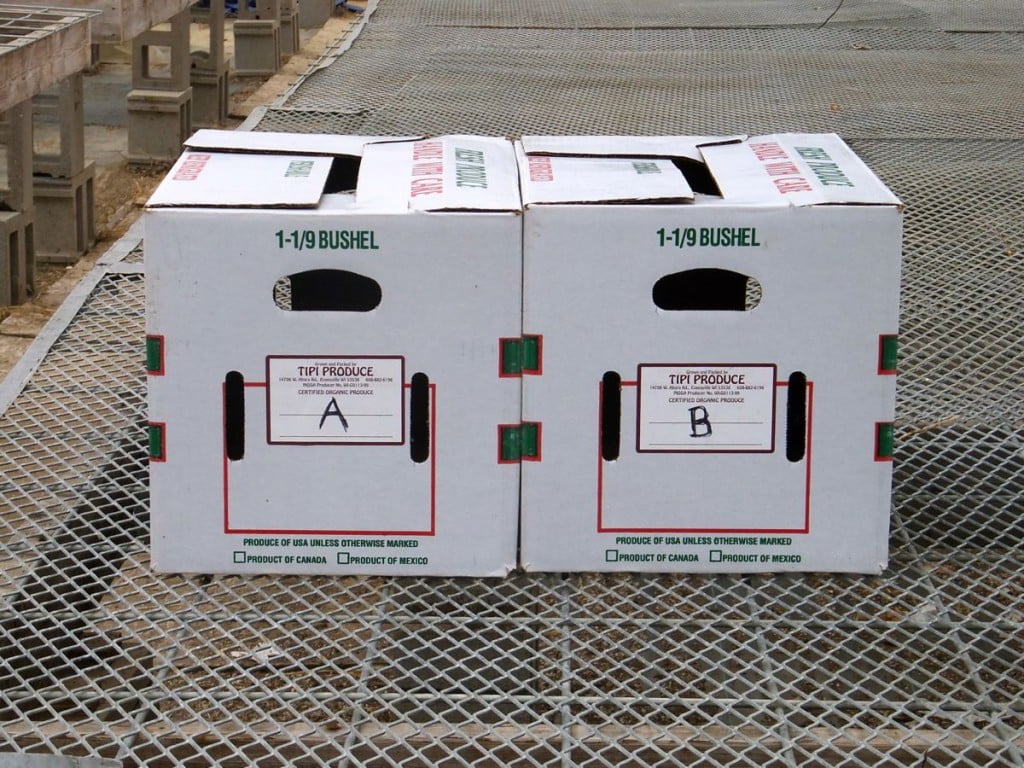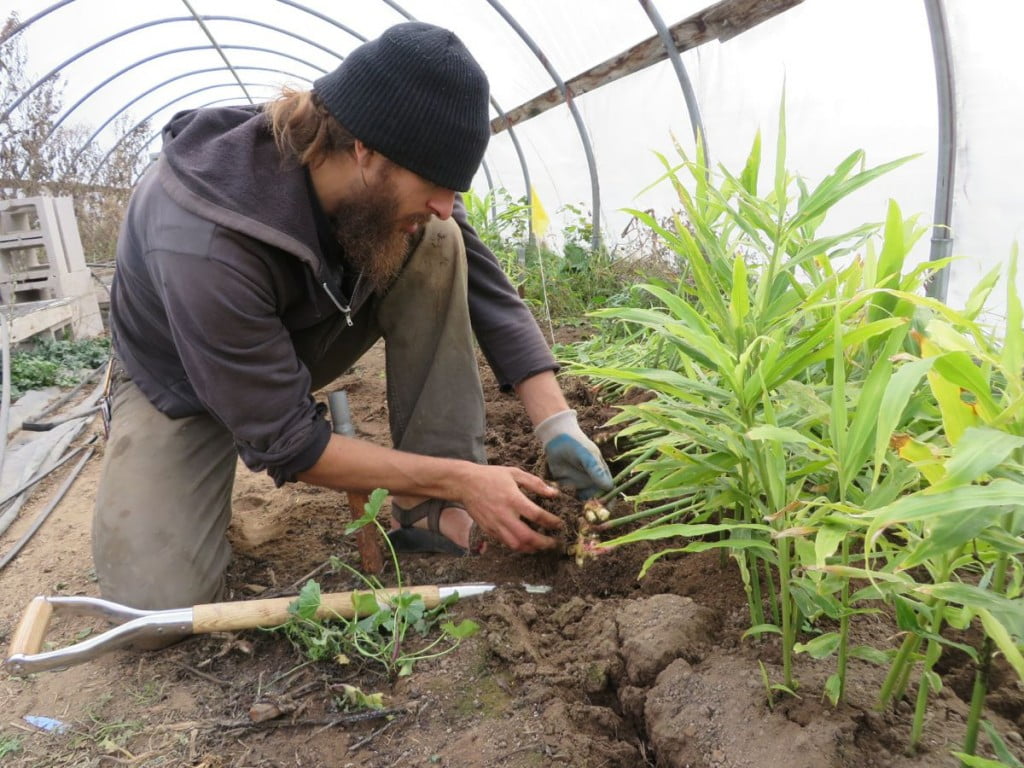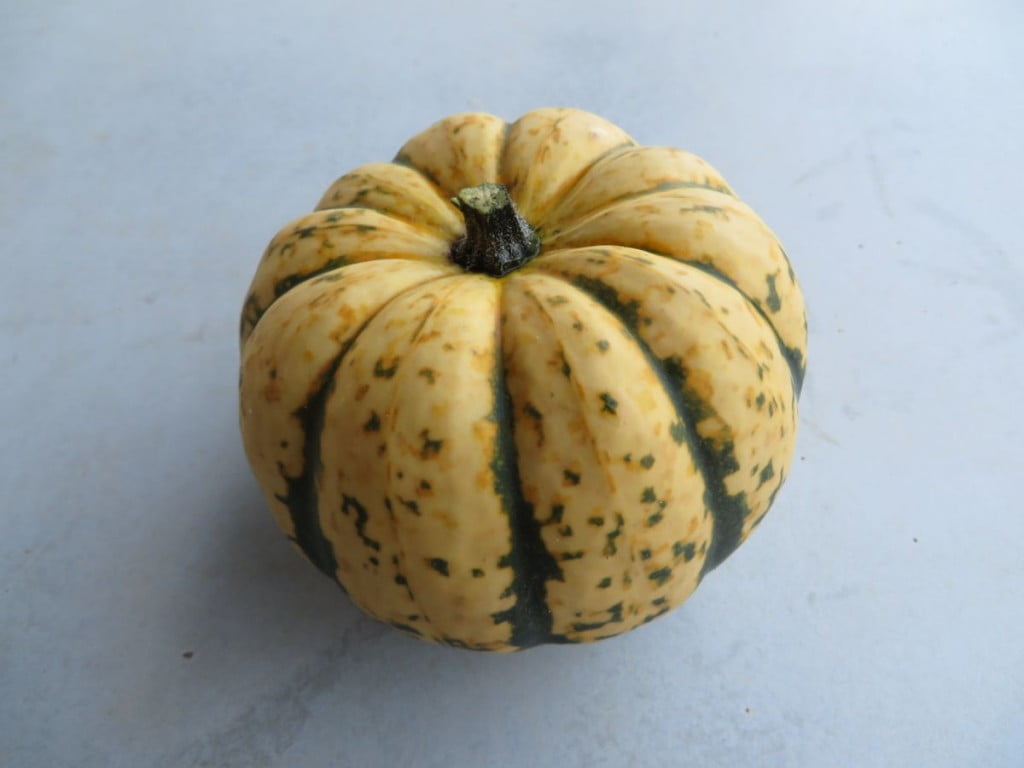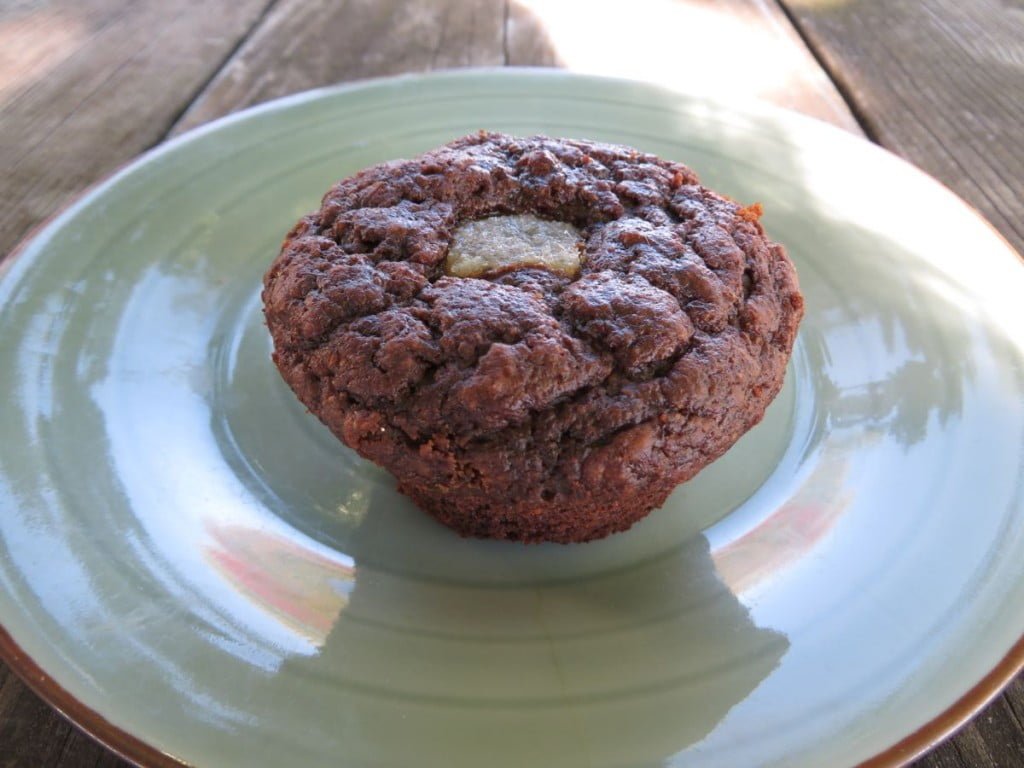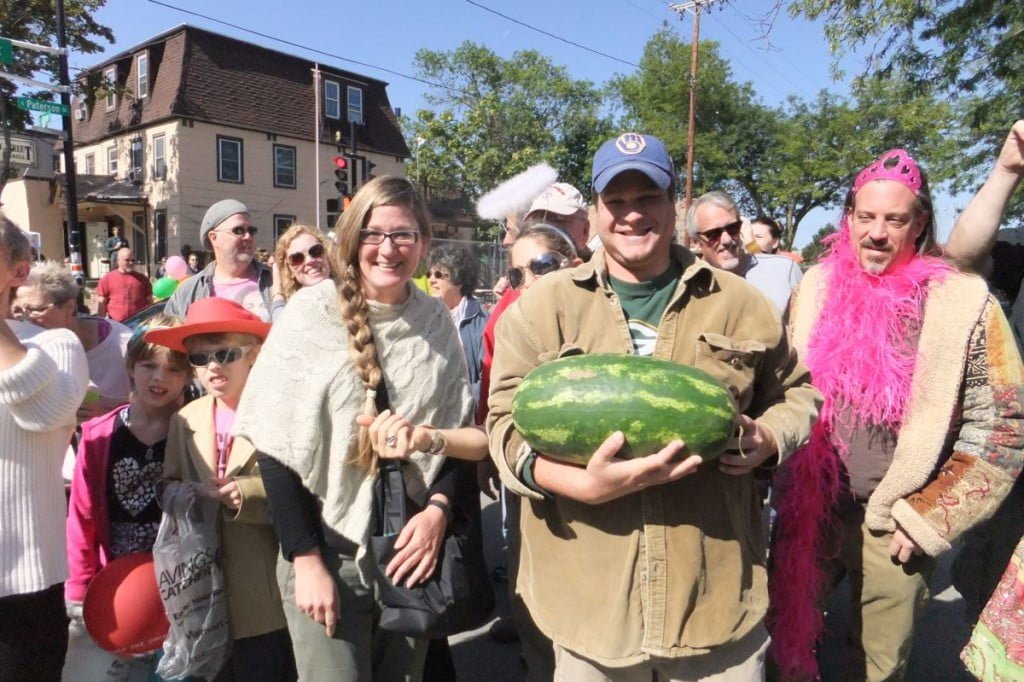Yearly Archives: 2014
Storage share (Nov. 20/21, 2014)
- On: November 19, 2014
 0
0
Things you need to know about your winter share
* Your delivery will consist of two different boxes, labeled “A” and “B”. Take one “A” box and one “B” box. The boxes contain different vegetables.
* Please pick up your boxes on the day of delivery, during the normal hours for your site. Don’t count on picking up late or the next day. It will be very cold during the deliveries and the produce will freeze overnight at the unheated sites.
* Outpost members, please get your boxes on Friday. Do not ask the Outpost staff to hold your boxes until Saturday; this is their busiest weekend of the year.
* Members at outdoor sites, please carefully put the blankets back on the boxes. That keeps everyone’s produce in good shape.
Veggie List and Storage Info (Storage share, 11/20 and 11/21/14)
We hope you enjoy this shipment of veggies! Strategize to use them well, as some will last longer than others.
* These vegetables are the most perishable: fennel, kale.
* These are the next-most perishable: Brussels sprouts, cabbage, leeks and onions. Keep an eye on your butternut, potatoes and sweet potatoes. The last two are susceptible to drying out.
* These will last the longest: Beauty Heart radish, beets, carrots, celeriac, garlic, parsnips and rutabaga.
Box “A”
Beauty Heart winter radish, 1.5 lb
Beets, 3 lb
Brussels sprouts, 1.1 lb
Carrots, 6 lb mixed colors
(orange 4 lb, yellow 1 lb, purple 1 lb)
Celeriac
Fennel, 1
Kale, 1 bunch
Leeks, 3 lb
Parsnips, 3 lb
Rutabaga, 1.5 lb
Savoy cabbage
Box “B”
Butternut squashes, 12 – 13 lb
Sweet potatoes, 7 lb
Russet potatoes (or mixed russets & reds), 5 lb
Yellow potatoes, 5 lb
Onions, 5 lb
Garlic, 4
Beauty Heart radishes (round, white with pale green shoulders and bright pink interior) – Refrigerate. The interior color is lovely. Slice thinly and add to salads, cook lightly in mixed vegetable medleys or cut into matchsticks and add to pasta salads. We enjoy grated carrot and Beauty Heart salads all winter.
Beets – Refrigerate in a plastic bag. Beets will store for two months or longer.
Brussels sprouts – Refrigerate in a plastic bag. Eat soon.
Cabbage – Refrigerate. Cut off chunks as needed.
Carrots, orange. Refrigerate in a plastic bag. Will keep for several weeks.
Carrots, yellow and purple. These varieties are pretty AND they taste good. The purple carrots will turn your tongue green. That will get the kids interested.
Celeriac – Will store for months in your fridge. Cut off chunks as needed.
Garlic. Can be stored at room temperature.
Leeks. Refrigerate and eat within three weeks. Leeks are not a long-storage crop. You may need to strip off one or two outer leaves to freshen the leeks before you cook them.
Onions: Store in a cool, dark spot or refrigerate. Protect from light. Exposure to light stimulates sprouting. Refrigerate if you expect to hold for more than one month.
Parsnips (These look like rough white carrots.) – Refrigerate in a plastic bag. Parsnips will store for two months but will darken in color.
Potatoes: Can be stored at room temperature or in a cool spot, but must be kept in the dark so they do not turn green. They will store longer if kept cool. Around 40 – 50 F is ideal. I find these potatoes from Chad Malek are unusually thin-skinned. This is great for cooking, but means they lose moisture quickly. Keep them in the paper bag, then cover the bag with a cloth or a loose plastic bag to their moisture loss.
Rutabaga (round root, cream-colored with purple shoulders) – Cover and refrigerate. Will store for several months.
Sweet potatoes – These are the Covington variety, and have developed excellent flavor and sweetness. Store at room temperature, no lower than 55 F. Keep them on your kitchen counter where it’s easy to keep an eye on them. Cook promptly if they start to soften. The roots come in a wide ranges of sizes and all are good.
Winter squash – You will receive three to six squash, depending on size. They are a mix of varieties: Metro, Waltham, JWS. Store winter squash in a cool, dry place. 50 F is ideal. Do not put in a plastic bag. Inspect your squash frequently and cook promptly if you see any soft spots developing. You can cook, mash and freeze the squash for future use. I find that you can refrigerate cut raw squash for up to one week. This runs counter to the accepted way to store squash, but is useful if you want to cook just half a squash at one time. Try microwaving your squash for one to two minutes before cutting or peeling. This softens the squash and makes large butternuts easier to handle.
What are you cooking for Thanksgiving?
We are creatures of habit when it comes to Thanksgiving. Here are our plans so far: brined roast heritage turkey from Matt Smith at Blue Valley Gardens (Beth), Brussels sprouts with garlic-mustard vinaigrette (Steve), roasted sweet potatoes with garlicky yogurt dip (see below, Sophie), glazed butternut squash (Beth), crunchy carrot-Beauty Heart salad with sesame-seed dressing (Steve), homemade applesauce (Ari), cranberry sauce (friends), and apple pie (Sophie). I’d like to add a raw kale salad, if I can get our neighbor to give us her recipe. We love celebrating Thanksgiving and the end of harvest season!
Menu Ideas
There are so many great Thanksgiving recipes and menus online right now. Many include veggies that you will receive in this delivery. Here is a list of the recipe sites I rely on. Each site has lots of recipes which feature vegetables. Search any of these sites if you are stumped about what to do with your storage veggies.
* I enjoy the Food52.com site. They have posted an entire section on Thanksgiving, including 13 dishes for feeding vegetarians on Thanksgiving. I look forward to trying their recipe for Variegated Spiced Latkes, which combines potatoes, parsnips and sweet potatoes.
* The New York Times as a brand-new iPad app called Cooking. It is good! They post appealing recipes and recipe collections every day. For example, we recently made Spicy Pan-Fried Noodles with the last of our scallions and peppers and it was excellent. In my opinion, Melissa Clark is the best NYT food writer. She’s practical and her dishes are always flavorful. Mark Bittman and Martha Rose Shulman are other favorites. The app and recipes appear to be free to the public, but I think you need to be a NYT subscriber to save recipes.
* Smitten Kitchen has posted new Pinterest boards for both Thanksgiving, Savory and Thanksgiving, Sweet.
* The Kitchn. I found this site after wandering over from their Apartment therapy home-design site. Good recipes.
* 101cookbooks. Always has good vegetarian recipes. The author has not posted this year’s collection of Thanksgiving recipes yet but I keep checking!
* Finally, remember that we have access to the entire catalog of Local Thyme recipes all winter. Check them out for Thanksgiving ideas.
Garlicky Yogurt Dip
This dip is great with everything. We enjoy it with roasted sweet potatoes or winter squash, raw carrot sticks, or lamb meatballs. When short on time, I make the basic dip, but it is especially nice with any fresh herb. I’ve prepared this with several olive oils but like it best with Spectrum organic extra virgin olive oil because it is fragrant and not bitter.
Basic ingredients:
1 medium clove garlic
2 Tbsp. olive oil
1 cup plain nonfat Greek yogurt
1/8 tsp salt
1/4 tsp paprika
Optional additions:
Lemon juice
Any finely-minced herb: parsley, cilantro, mint. Start with 1 tsp.
Finely minced chives OR 1 small scallion, finely minced
1. Grate the garlic clove into a bowl or a wide-mouthed pint jar. Add the olive oil. Stir and let sit for 5 minutes for the garlic to diffuse into the oil.
2. Mix in the yogurt, 1/4 cup at a time. Stir vigorously. Taste after you’ve added 1/2 cup, so you can recognize how well the yogurt and olive oil taste together.
3. Add the salt, paprika and any optional additions and stir well.
4. Evaluate the flavor. Add more olive oil and/or salt if the flavor is not ‘umami’ enough.
Good bye! Stay warm!
- On: November 12, 2014
 0
0
This is the final week of our regular CSA season.
Weekly and purple EOW members, go get your last box!
We would like to thank each of you for joining our farm this year. We appreciate your support and encouragement. We hope you enjoyed the produce and the experience. From our perspective, it was an excellent growing season. Most crops thrived in the mild weather. The broccoli, cauliflower and Romanesco were more productive than we have ever seen. Tell us in the annual survey if you wanted that much broccoli, cauliflower and Romanesco. Really, we’d love to know.
This was our finest work crew ever. Longterm employees took new responsibilities, freeing Steve to concentrate on his own work. Several longterm Tipi people are moving on to new adventures in agriculture. We will miss Michael who is moving back to Missouri to start his own farm after working for us for three years. It’s hard to imagine life without Clint, who is leaving after six seasons to learn more about seed production. We already miss David and Bri who are working in the organic certification industry in California. David worked for us for seven years, starting as a high school student. A few years with us, and he chose the agronomy program at UW/Madison for his college degree. It’s sad when people leave after working for us for many years, but we are thrilled when they stay in agriculture. We are seeding the world with new farmers, and that is a wonderful, satisfying thing. Have a great winter. Beth and Steve
Final Details.
– Please make sure that everyone who participates in your CSA share knows the CSA has finished.
– Please return all empty CSA boxes this week. It’s best to unpack your box this week, and leave it behind. It’s OK to leave empty boxes at your site during the next two weeks. Just prop them up outside the garage if the door is closed.
– Our Local Thyme subscription is good for an entire year, so you have access to their website and recipes until spring. Use it this winter. Contact me if you still want to register for their website. It’s not too late.
– Storage share members, please read our 11/5/14 email about your upcoming delivery.
– Look for our produce through the winter at Willy Street Coop, Outpost Natural Foods, Basics Coop (Janesville), Health Hut (Brookfield), and at Whole Foods (Madison store). We have a big supply of carrots, cabbage, leeks, onions, beets, celeriac, parsnips, turnips, rutabagas and winter radishes to wash and sell through the winter.
2014 survey and 2015 CSA registration.
– Watch for an email from us in the next few days, once we have our survey ready. We are eager to hear your thoughts on this season.
– We plan to open 2015 CSA registrations within a week. There will be an opportunity to register early at discounted rate.
Farm news: Winter descends.
We do not appreciate the sudden cold weather. We hoped for a few more weeks to wrap up our harvests and clean up the farm before winter. Oh well, the weather is not in our control. Next spring will be busy because our fall field work is unfinished. We hurried to bring in our final crops this week. Last carrots came in from the fields on Saturday, last greens on Monday, last Brussels sprouts on Tuesday, last leeks came in today. Our crew hustled this week.

Simone and Steve harvest the final row of carrots. That was a relief. It was still warm on Saturday.
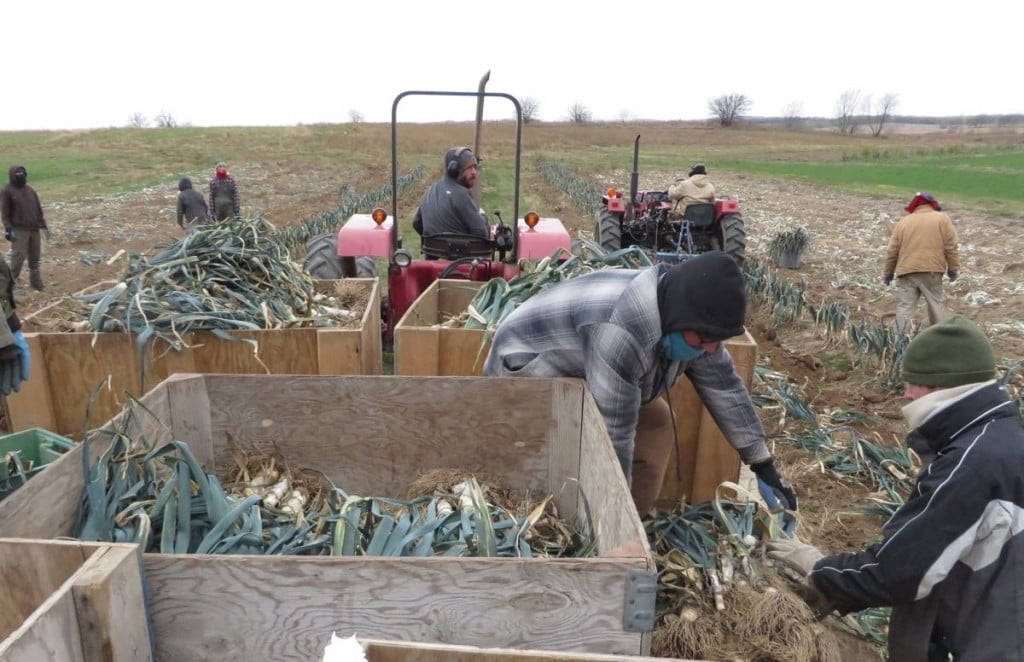
Leek harvest today was cold and rushed. Our crew usually trims the leek tops and roots at harvest. Not today; they just pulled them in as quickly as possible. Anything still in the field could be ruined by tomorrow morning. From left, Andy, Simone, Jon, Michael (on tractor in center), Steve (on tractor in background), Joel, Jory and Billy gather leeks. Steve is undercutting the leeks to pop them out of the ground.
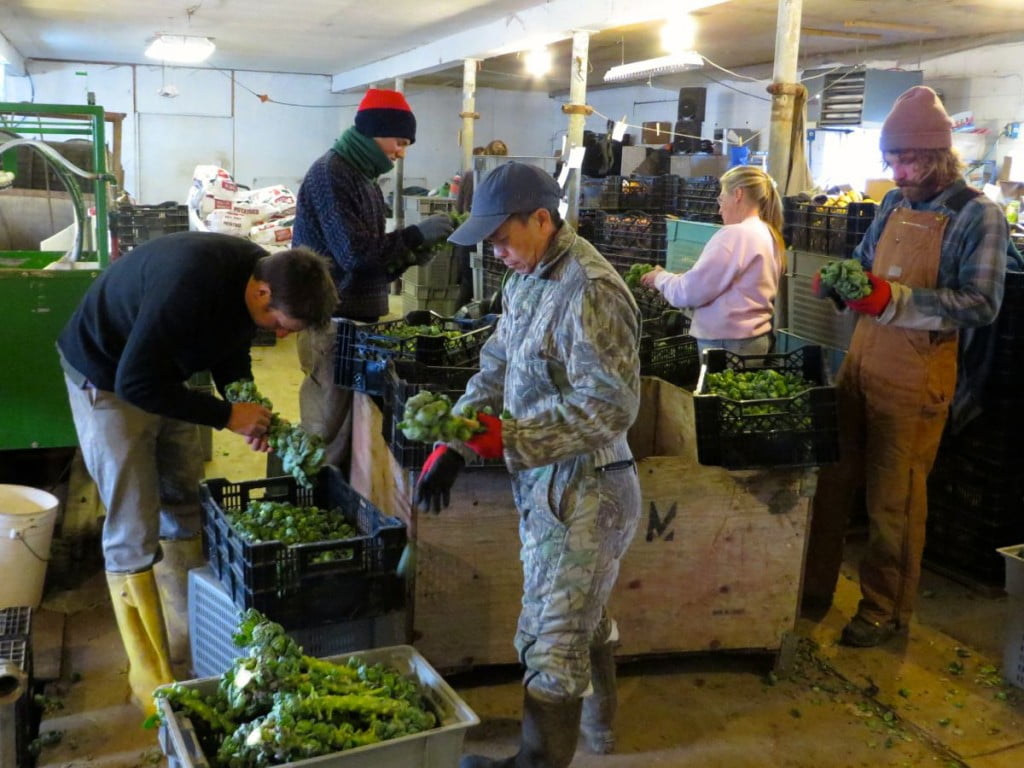
We did our leek and Brussels sprouts prep inside this week. It’s almost impossible to work on these vegetables outdoors at temperatures below freezing. From left, Tristan, Jory, Bee, Simone and Michael pluck Brussels sprouts from stalks. In the back, Bonnie and Kerry weigh potatoes behind stacks of sweet potatoes and squash washed and ready for this week. Everyone looks serious but that’s only because I had my camera out. Group jobs like this are social and fun.
Your leeks this week need light washing. Our outdoor water systems are shut down, and it was too crowded indoors to spray water about.
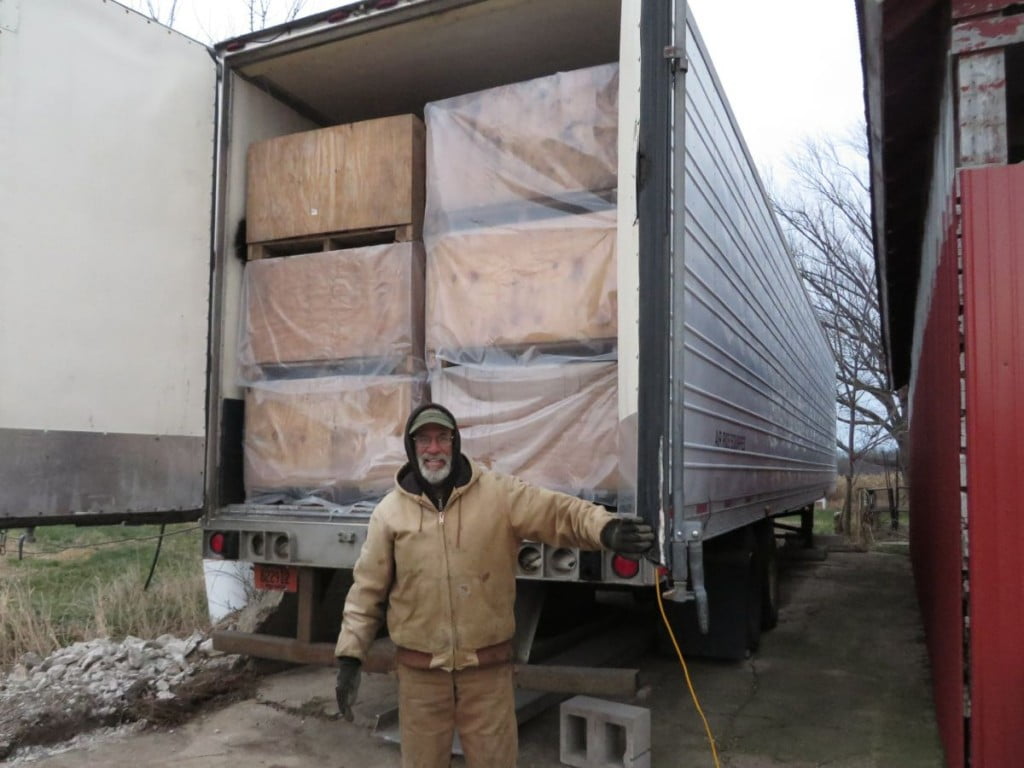
Remember the used semi that we bought for extra storage? We filled the trailer plus all our normal coolers. Steve is satisfied. Please buy our carrots this winter; we can’t eat that much carrot soup.
Veggie list and veggie notes (Nov. 13/14, week #26, purple EOW)
Sweet potatoes, about 2 lb
Red potatoes, 3.5 lb
Brussels sprouts, 0.85 lb
Butternut squash, 1
Leeks, 1.5 to 2 lb
Beets, 2 lb
Parsnips, 1.5 lb
Lacinato kale, 1 modest bunch
A small pepper or two
We will have the next box ready for you … next spring!
Peppers – These are mostly small Orano peppers. Eat soon; they will not store for long.
Lacinato kale – Bunches are modest size. This kale is not perfect, as expected by this time of year.
Brussels sprouts – The sprouts are nice this year, but it has not been a very productive year for Brussels sprouts.
Leeks – As I mentioned above, you will need to wash your leeks.
Final green EOW week (Nov. 6/7)
- On: November 05, 2014
 0
0
Green every-other-week (EOW) members, this is your final delivery (November 6/7)
Weekly members and purple EOW members, your final delivery will be next week (Nov 13/14).
Wrap-up for green EOW members
Thank you for being members of our farm this year! We could not continue to farm without dedicated customers like each of you. This has been an unusually good growing season. We hope you have enjoyed eating your produce as much as we have enjoyed producing it.
A few details:
– Please read next week’s email for our annual survey. Tell us your thoughts on this season. We will incorporate your ideas into our plans for next year.
– Please return all your empty CSA boxes. It is best to unpack your final box, and leave the empty box behind. It will save you a trip to your site to return the box. Please hunt through your house, garage, and car, and return any remaining empty boxes this week or next week.
– We expect to open 2015 registration soon for current Tipi members. Watch for emails from us.
Photos of our farm for the Wisconsin Department of Ag
Tipi CSA member Jody Steele photographed our farm as part of a contract with the WI Dept of Agriculture (DATCP). The goal is to gather photos representative of all types of farming that occur in Wisconsin. Apparently they have an overabundance of cow and tractor photos. DATCP chose two of Jody’s Tipi photos to incorporate into their portfolio. Jody visited during celeriac harvest, which is very timely because we will pack celeriac for everyone this week. Jody, thank you for sharing these photos with us.
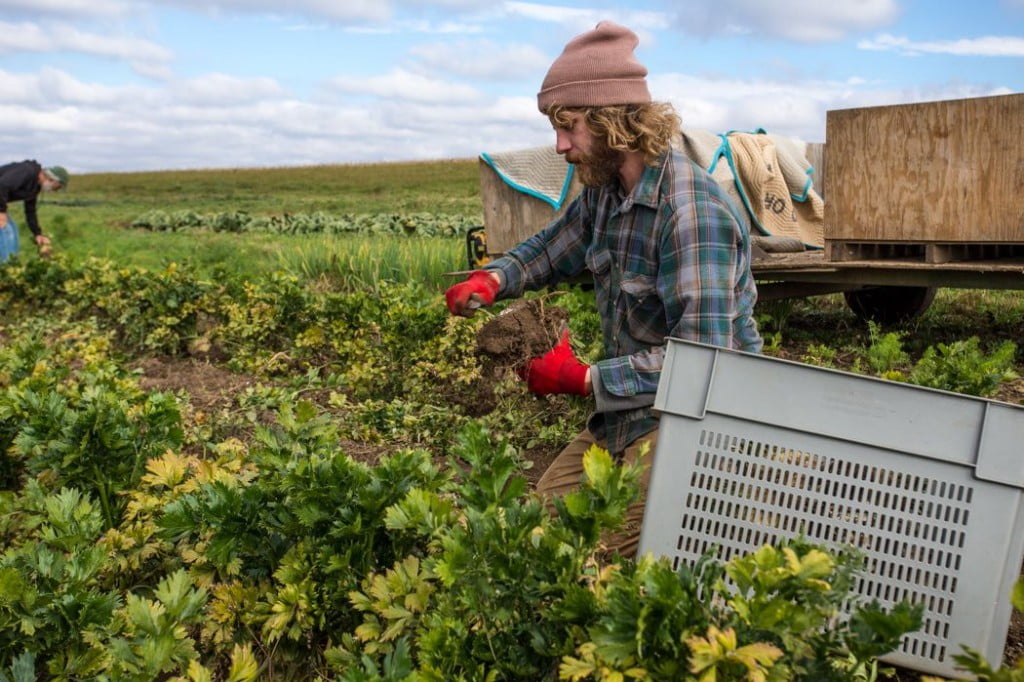
Michael trims celeriac. I warned Jody that celeriac harvest would look as though we are harvesting lumps of mud.
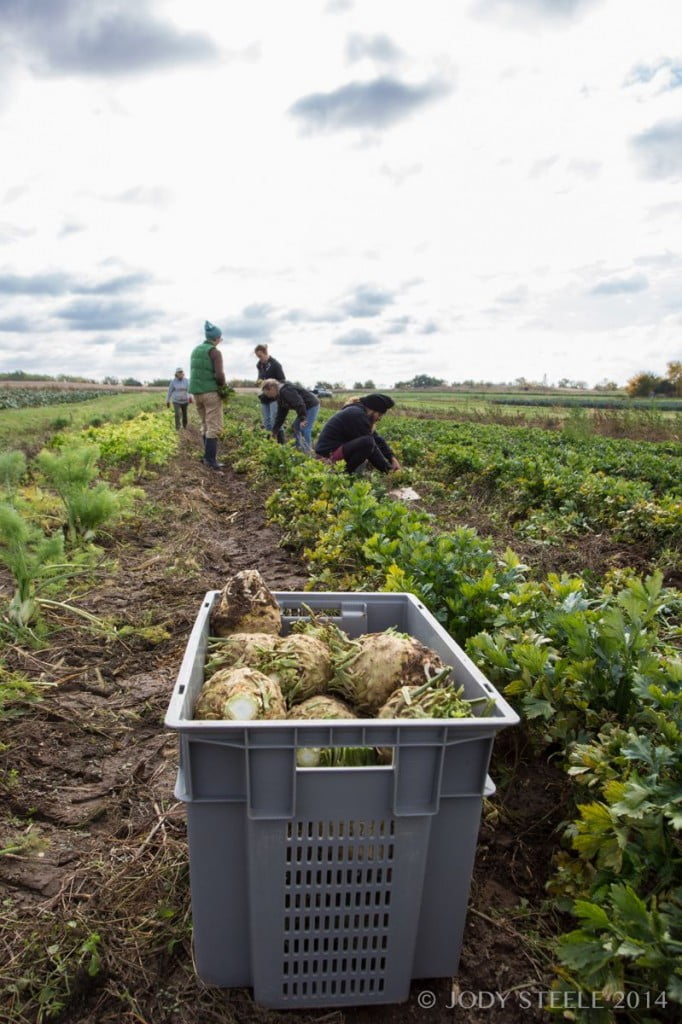
Fortunately, they clean up to look like an ancient roots. The celeriac/celery fragrance is intense and wonderful during harvest.
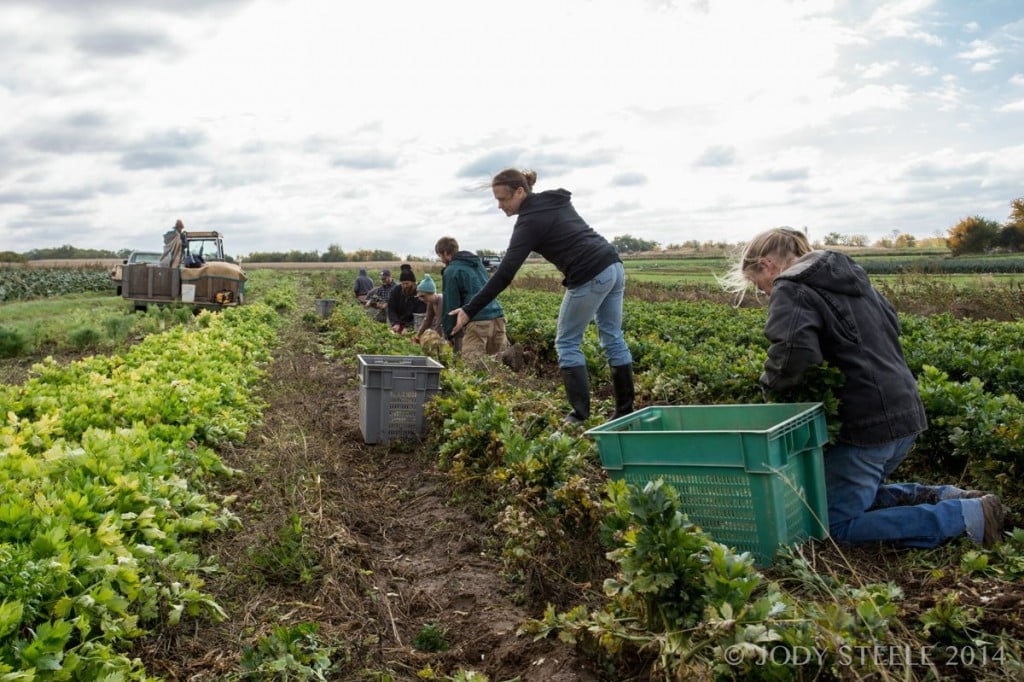
Our storage crop harvests are group activities. From left in the distance, Michael, Joel, Clint, Bonnie, Billy, Karen and Simone harvest celeriac. We undercut the roots with a tractor and digger, but there’s much work by hand to trim the tops and extra roots.
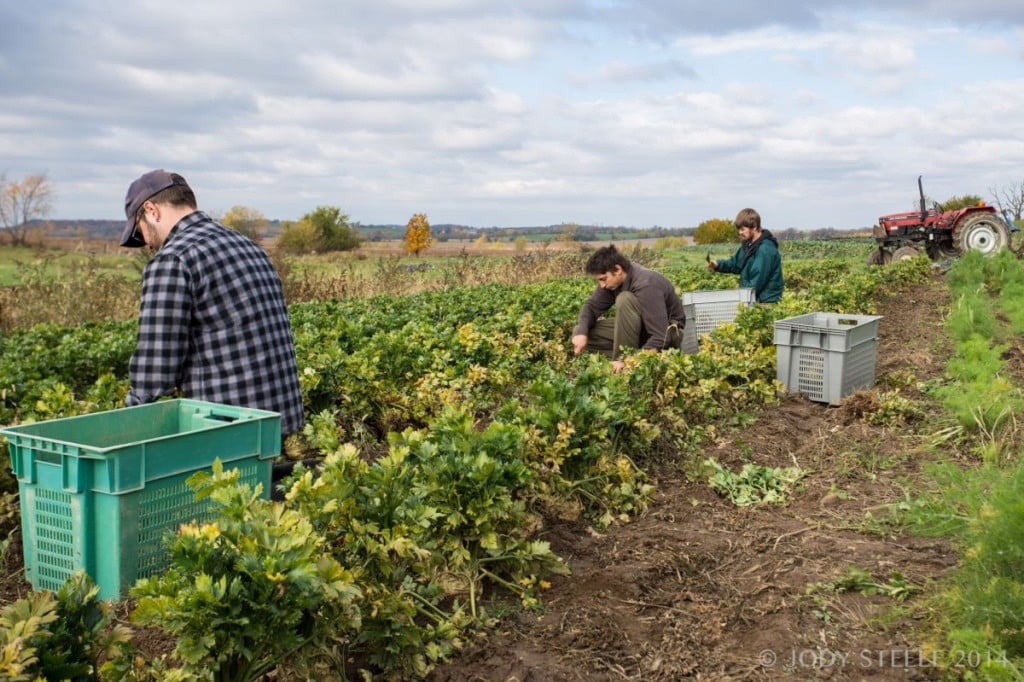
From left, Joel, Tristan and Billy harvest celeriac.
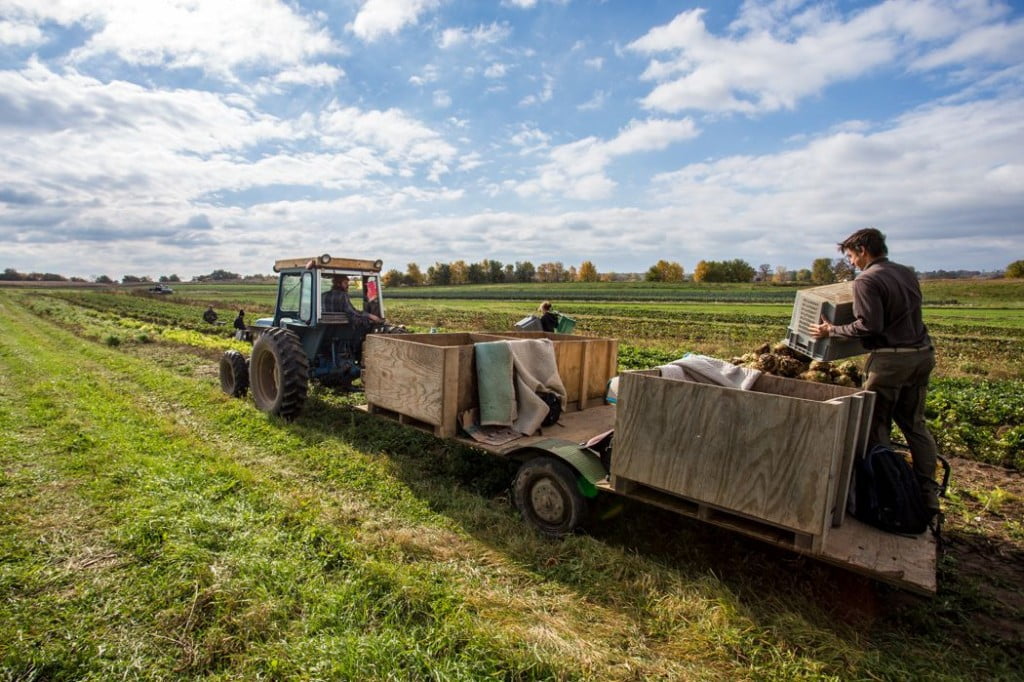
This is one of the photos that the Dept of Ag chose. Tristan loads harvested celeriac into wooden bins. We will wash and sell the roots through the winter. Celeriac stores extremely well.
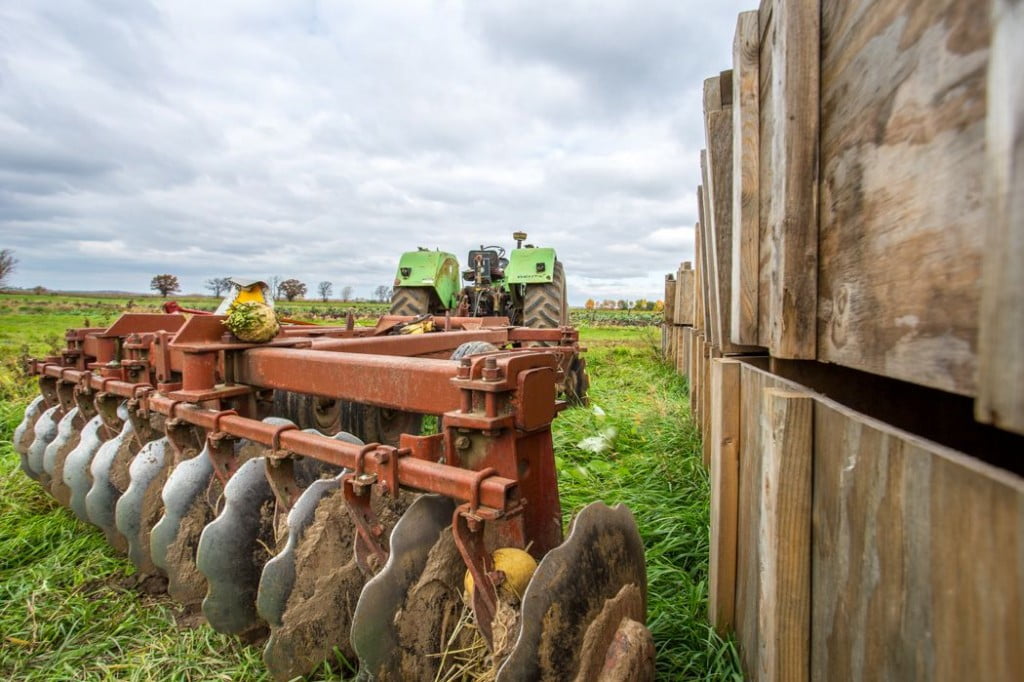
DATCP chose this photo too. This shows storage bins stacked on the right, plus our Deutz tractor and field disk. Steve was disking fields the day Jody visited, turning the finished crops into the soil, and preparing the fields to seed to cover crops.
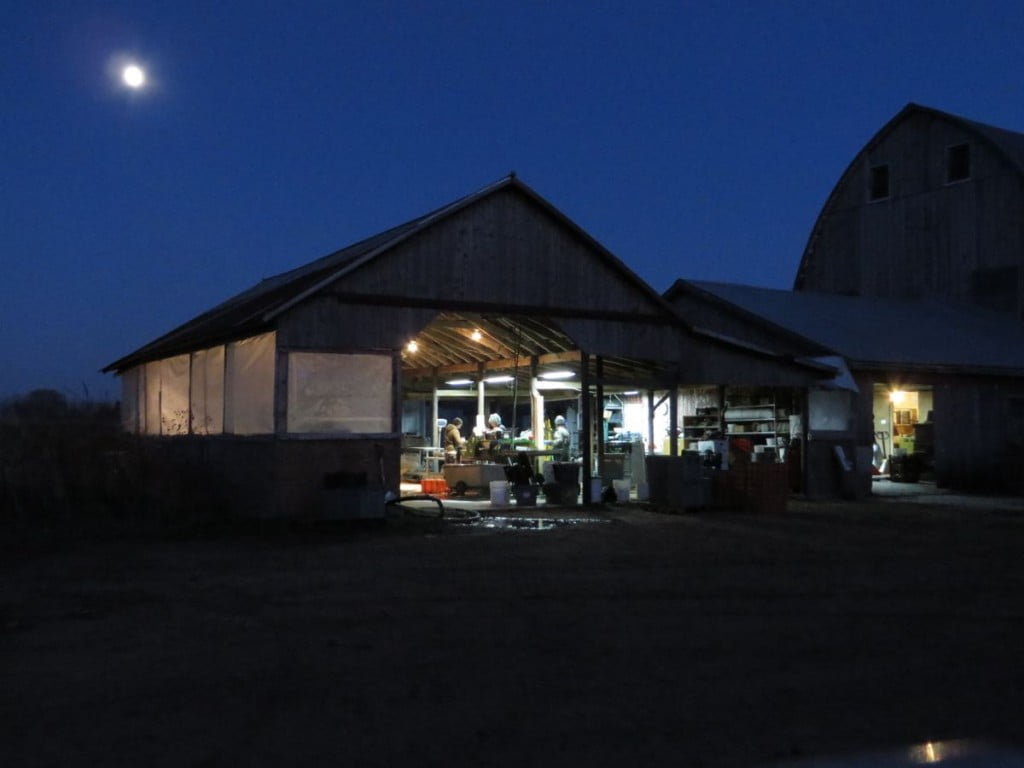
Moon over the pack shed. Our workdays end after dark now. It won’t be long before our outdoor work is done. We are racing to tuck away the remaining carrots and cabbage before temperatures fall dramatically next week. Wish us luck.
Veggie list and veggie notes (Nov. 6/7, week #25, final green EOW box)
Brussels sprouts, on the stalk
Butternut squash
Celeriac, 1 or 2
Kale, 1 bunch
Frying peppers, about 4
Carrots, 2 lb
Onions, 2
Garlic
Broccoli OR cauliflower OR purple cauliflower, 1 small head
Next week’s box will probably contain red potatoes, sweet potatoes, Brussels sprouts, butternut squash, leeks, beets, parnsips, a pepper, and (hopefully) some kind of leafy green.
Brussels sprouts – We are sending the sprouts on the stalk. Pluck from the stalk soon to keep the sprouts from wilting. Saves space in your fridge too!
If you are a new CSA member, please approach Brussels sprouts with an open mind. Many of us grew up eating awful, overcooked Brussels sprouts. These Brussels sprouts are completely different.
Here is our method to cook Brussels sprouts: Wash the sprouts and trim the cut ends. Cut an X in the stem end of large sprouts. Cut a single slit in small or medium sprouts. This does two things. It helps the Brussels sprouts cook evenly, plus it allows them to soak up any marinade or dressing. Place sprouts in a pot with one inch of water in the bottom and steam until tender, 7 to 10 minutes. If the sprouts are uneven in size, then set aside the smallest ones and add to the pot after the larger ones have cooked for a few minutes. Don’t overcook them! You can also oven-roast Brussels sprouts. Here are a few dressing ideas for cooked sprouts:
– Sherry vinegar/olive oil/Dijon mustard/garlic/white wine/salt and pepper. This is our favorite, especially when you combine the Brussels sprouts with slivered peppers and thinly sliced onions. Delicious warm, cold, or at room temperature.
– Balsamic vinegar/olive oil/garlic/salt and pepper
– Lemon juice and zest/melted brown butter/poppy seeds/white wine/garlic/salt
Butternut winter squash – These are the Waltham variety. It can be difficult (and hazardous) to cut these large squash. To soften your squash before cutting, microwave it for 1 to 2 minutes. This makes any squash easier to cut or peel.
Celeriac (knobby, round, bizarre-looking vegetable which smells like celery) – Flavorful celeriac is good raw or cooked. It is excellent in mixed roasted veggies or in soup. It’s especially good in cream soups, alone or mixed with potatoes. Grated raw celeriac is a great starting point for winter salads. Celeriac will store in your refrigerator for months. Cut off chunks as you need them. Peel before using.
Frying peppers – We harvested these last Friday, so use them quickly.
Something new, even now
- On: October 29, 2014
 0
0
We have something new to share, even this late in the season. We tried growing ginger in our smallest greenhouse. As a tropical crop, it needs the extra heat and shelter. Baby ginger is suddenly popular in the continental USA after a marketing campaign by Puna Organics, a Hawaiian farm that sells organically raised stock plants. That’s who we bought our cuttings from this year. The owner is quite colorful. Check out the Puna Organics website if you’re interested in guys with too many tattoos or women wearing coconut bikinis. We started the plants in March and they were finally ready to harvest this week. It was an experiment, so there’s just a bit to share with everyone this week. We’ll plant more next year so we can harvest enough for more than one delivery. It was a fun experiment!
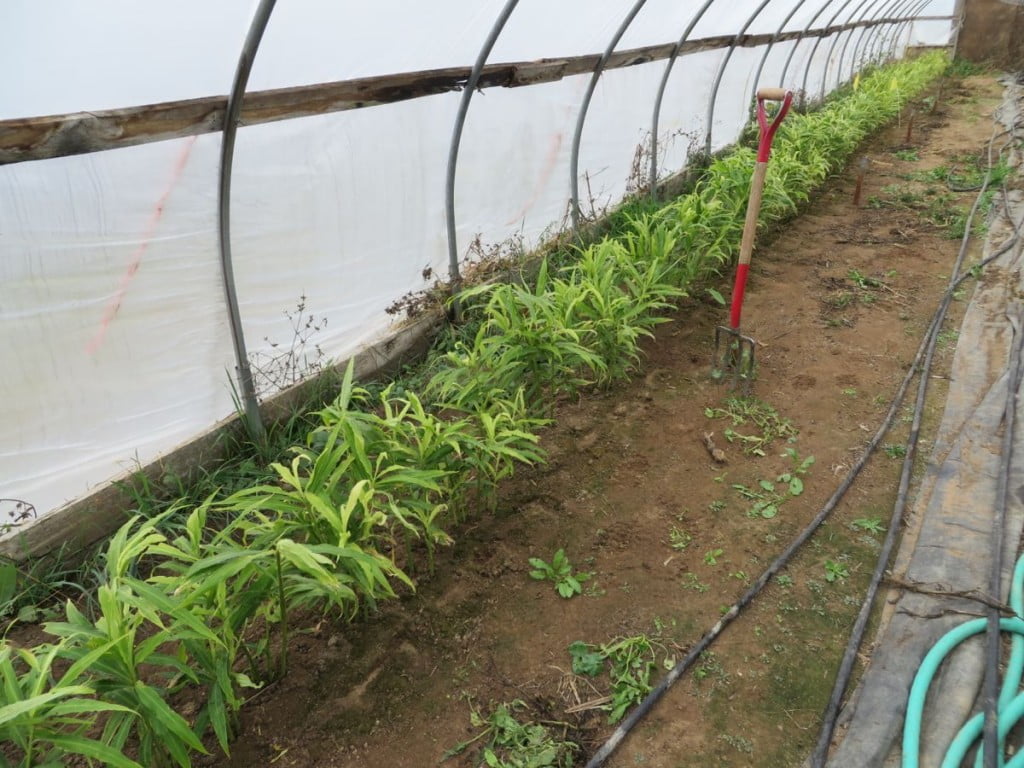
Ginger plants. This is our smallest greenhouse, one that we generally use for just six weeks in spring to acclimate plants to cool temperatures before they go outside. This house is a good choice for ginger because the sides roll up for ventilation during hot weather. Ginger is tropical but still doesn’t like temperatures over 90 oF.
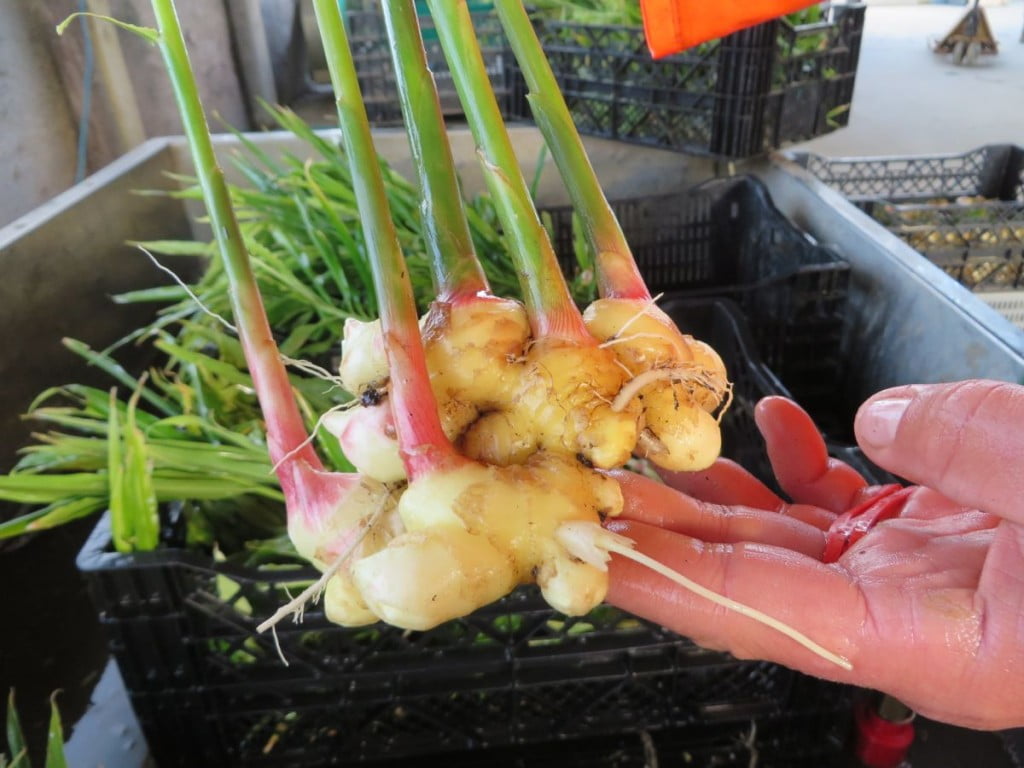
Isn’t it lovely? This ‘baby ginger’ has not yet developed the tan skin you see on ginger in the grocery store. That takes a longer growing season than we can achieve in Wisconsin. This is yellow ginger, more pungent than other ginger varieties.
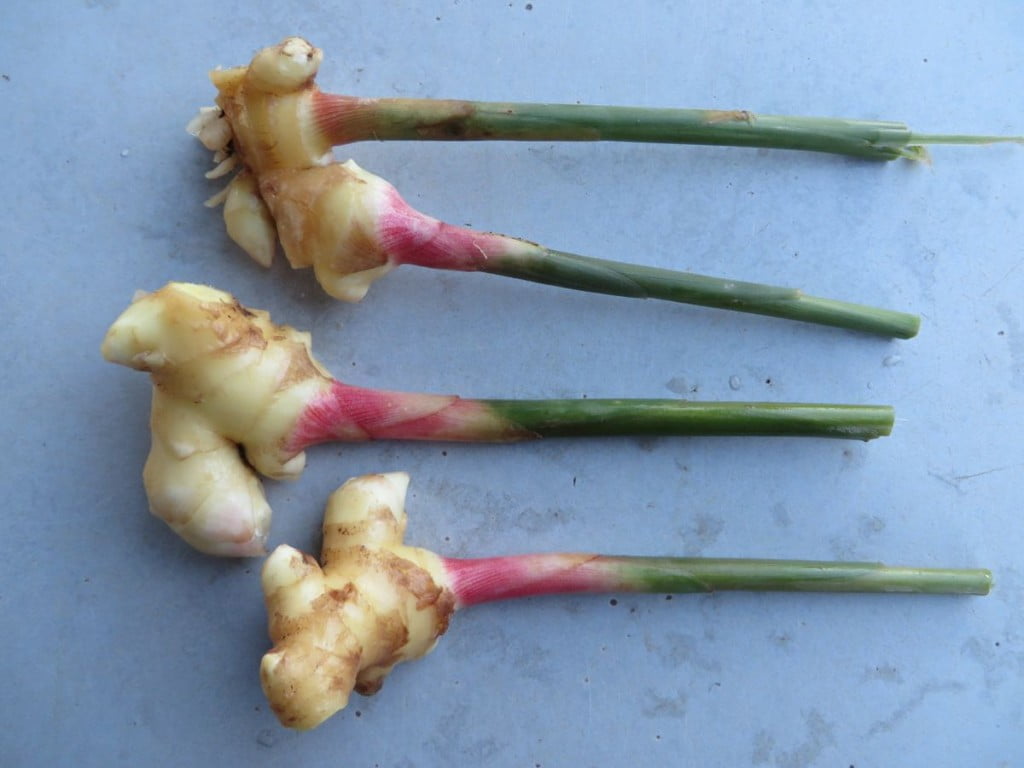
We cut it into small knobs so everyone could get a bit this week. It’s not much but we hope you enjoy it.
CSA countdown
November 6/7 (next week!) = final delivery for green EOW members.
November 13/14 = final delivery for weekly members and for purple EOW members.
Farm news
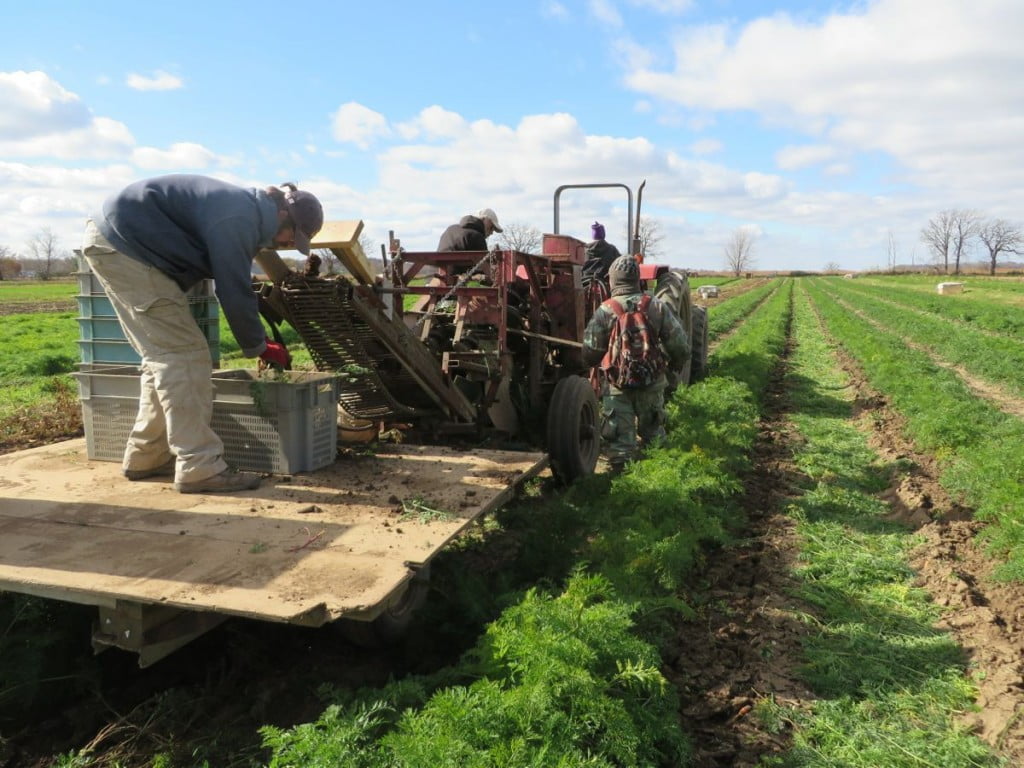
Carrot harvest continues. This looks like last week’s photo but now there are fewer rows of carrots.
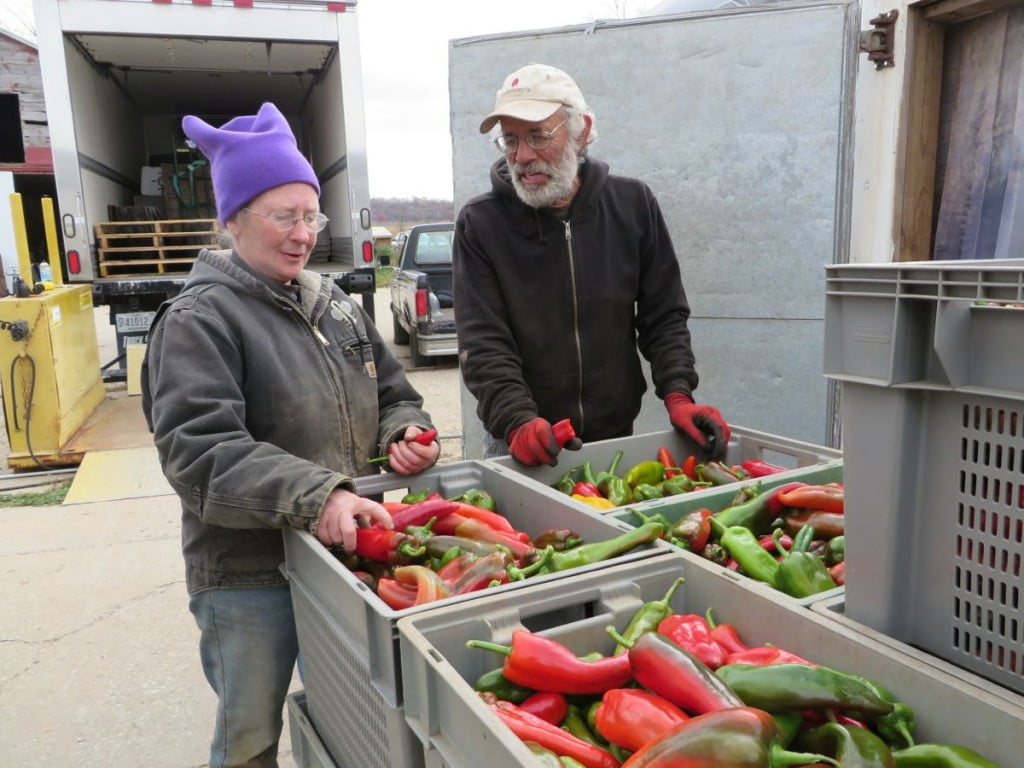
This week, we will strip the remaining peppers from the final pepper planting, the field Steve repeatedly saved from frost. Simone and Steve talk over the frying pepper varieties that we tested this year. The consensus: “Sweet Delilah” is a keeper, “Stocky Red” is a dud. Our longtime favorite “Carmen” is still the best.
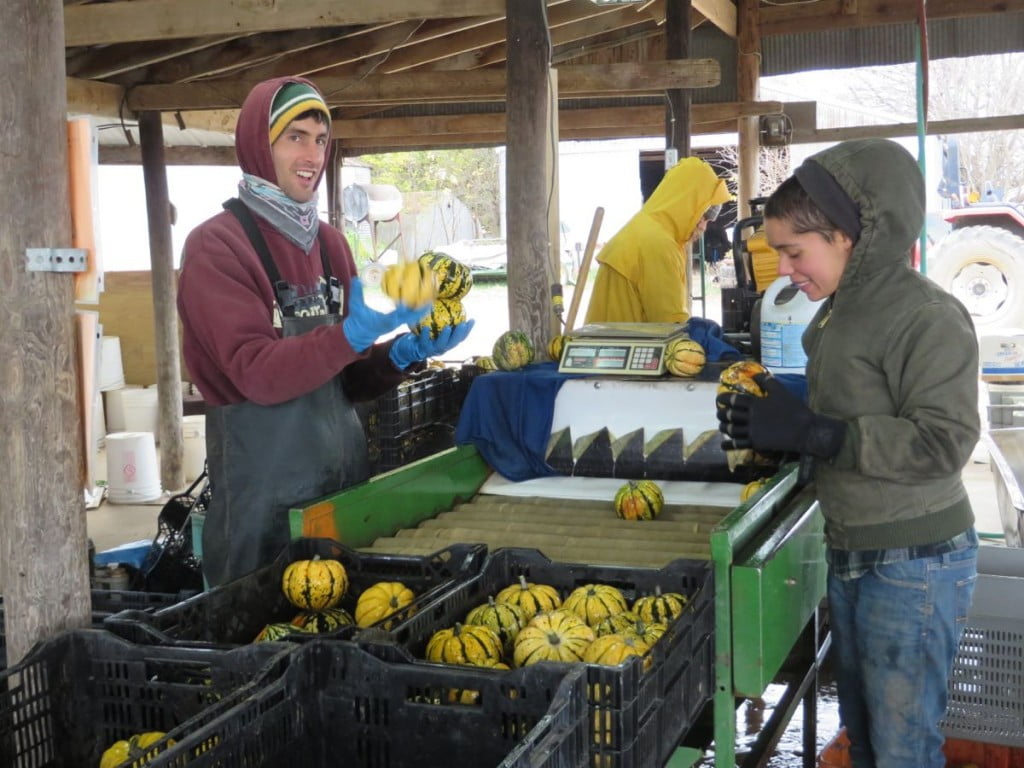
Jon, Jory and Boi wash the Sweet Dumpling squash you will receive this week.
Veggie list and veggie notes
Red cabbage
Sugar Dumpling squash, 2
(OR 1 Sugar Dumpling + 1 small butternut)
Broccoli, 1 or 2 heads
(A few members will get purple cauliflower instead)
Carrots, 2 lb
Frying peppers, about 4
Onions, 2
Garlic, 1
Baby ginger, 1 knob
Next week’s box will probably contain Brussels sprouts, butternut squash, celeriac, carrots, kale, scallions, and more.
Broccoli OR purple cauliflower – Only a few sites will receive purple cauliflower this week. Treat it like normal white cauliflower.
Baby ginger – Perishable. Use soon. Cover and refrigerate.
Sugar Dumpling squash – This is currently my favorite squash. We tested many winter squash varieties over the past few years. ‘Sugar Dumpling is one of the best. It looks like a Sweet Dumpling squash but is more substantial. Sweet, starchy, flavorful. We hope you enjoy them. Store at room temperature.
Winter squash hint: Sugar Dumpling and butternut can be difficult and dangerous to cut. Try microwaving your squash for 30 seconds to 2 minutes before cutting. It softens the squash and makes it easier to cut or peel.
Last chance to get a 2014 receipt.
- On: October 22, 2014
 0
0
Go to this link to send yourself a receipt for your 2014 CSA shares. I plan to dissemble this feature next week, so please send yourself a receipt now if you need one.
Host a new Tipi CSA site in 2015?
We are still looking for someone to host a new Tipi CSA site in the Madison area. If we find the right places, we might add two new sites. We are open to working in a member’s garage or in a workplace. Workplace sites are especially interesting because of the convenience they offer to members. Read more here, and contact us if you are interested.
Farm news and photos
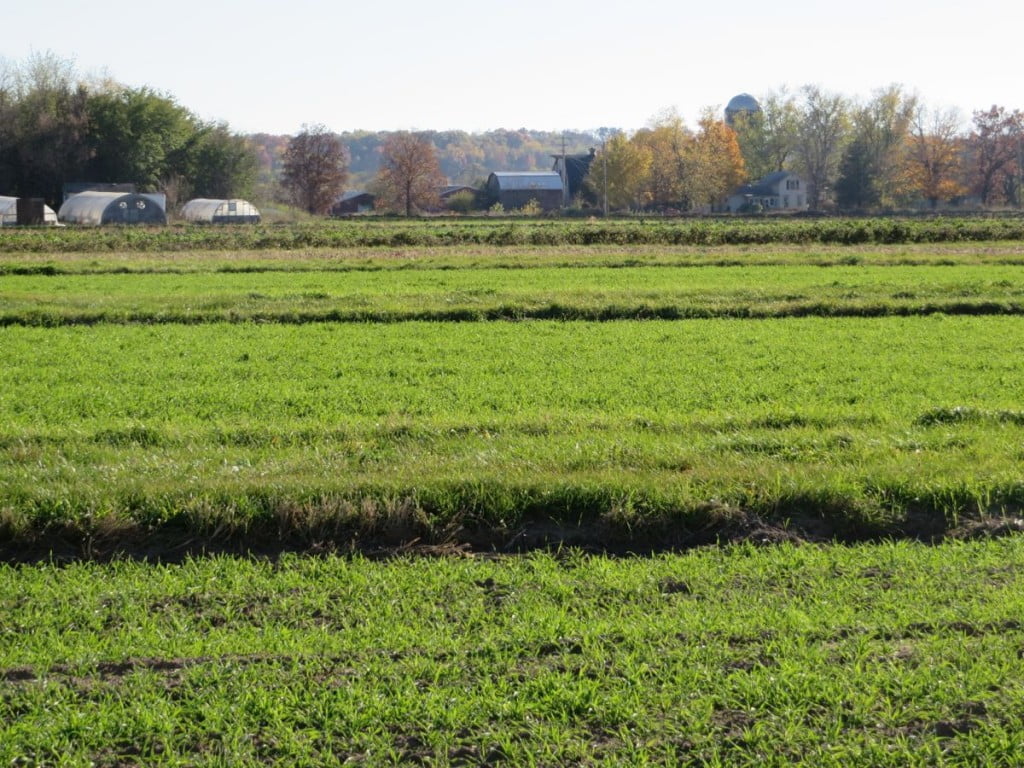
Would you believe me if I claimed this photo was taken in spring? Ha! The trees show the true season. Our cover crops are so lush right now.
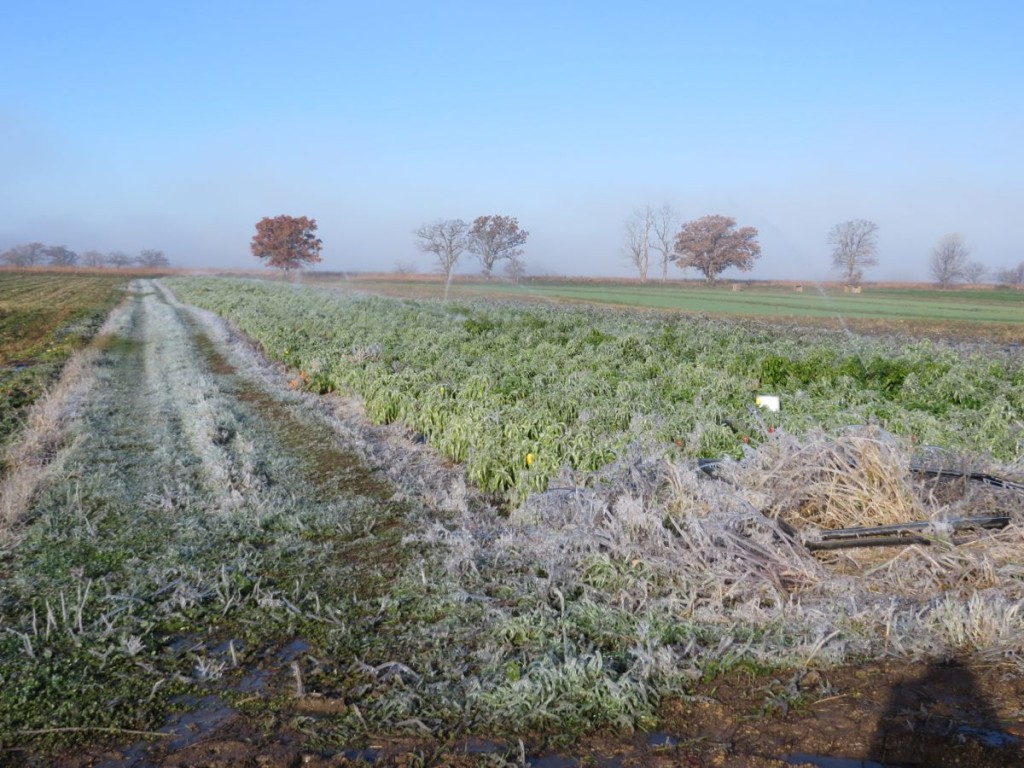
Steve has irrigated our pepper fields through all the frosts, including last night. Heat released as water crystallizes into ice keeps the plants at a steady 32 oF. Sounds crazy, but it works. That’s how we’ve had peppers for you during the last few weeks. Now we are down to one remaining pepper field. It is so difficult to let go.
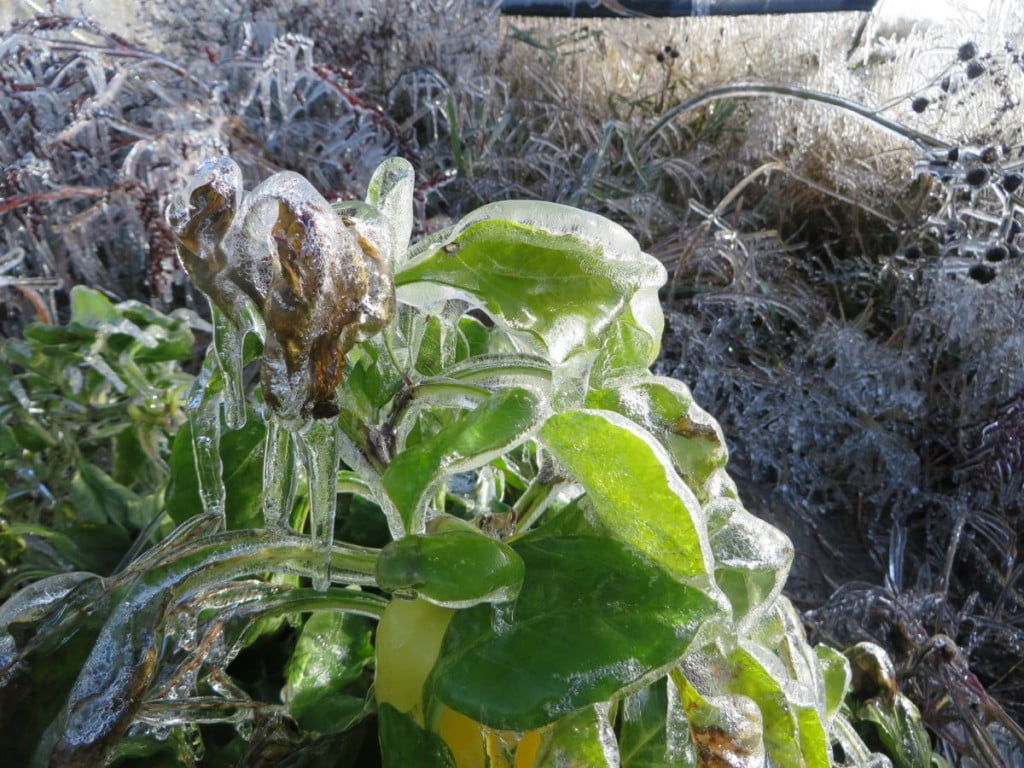
By this morning, the plants were coated with a thick layer of ice. See the yellow bell pepper under the leaves? It was perfectly fine once the ice melted.
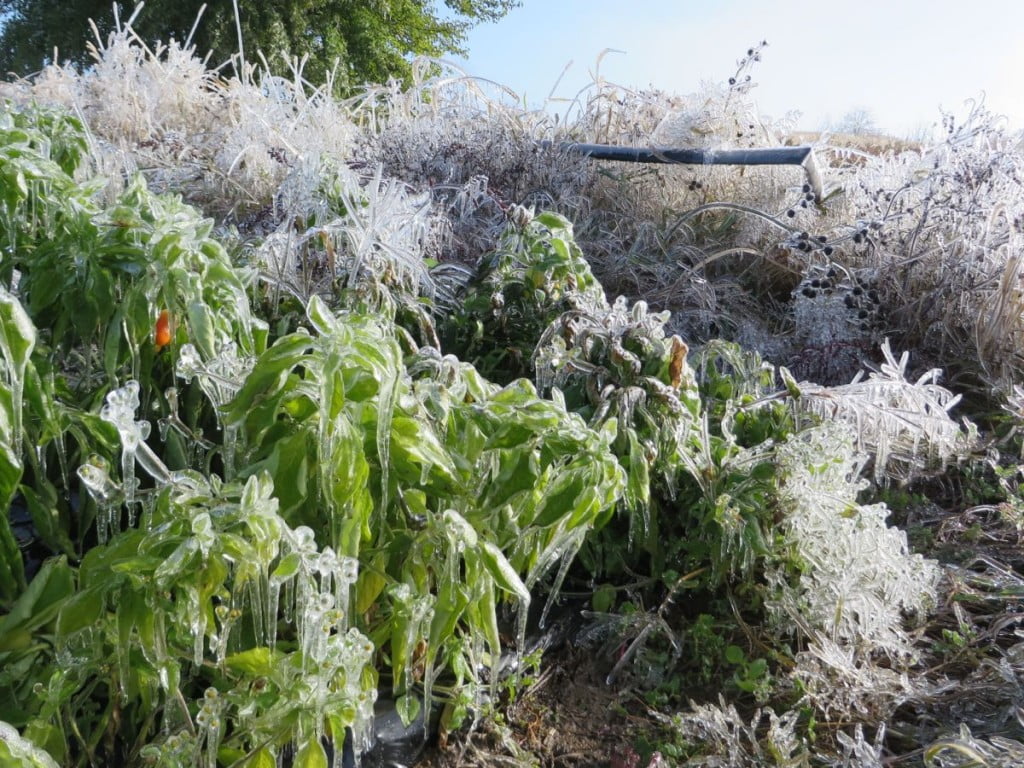
The ice can be gothic. How ironic – our last summer field was the only one covered in ice.
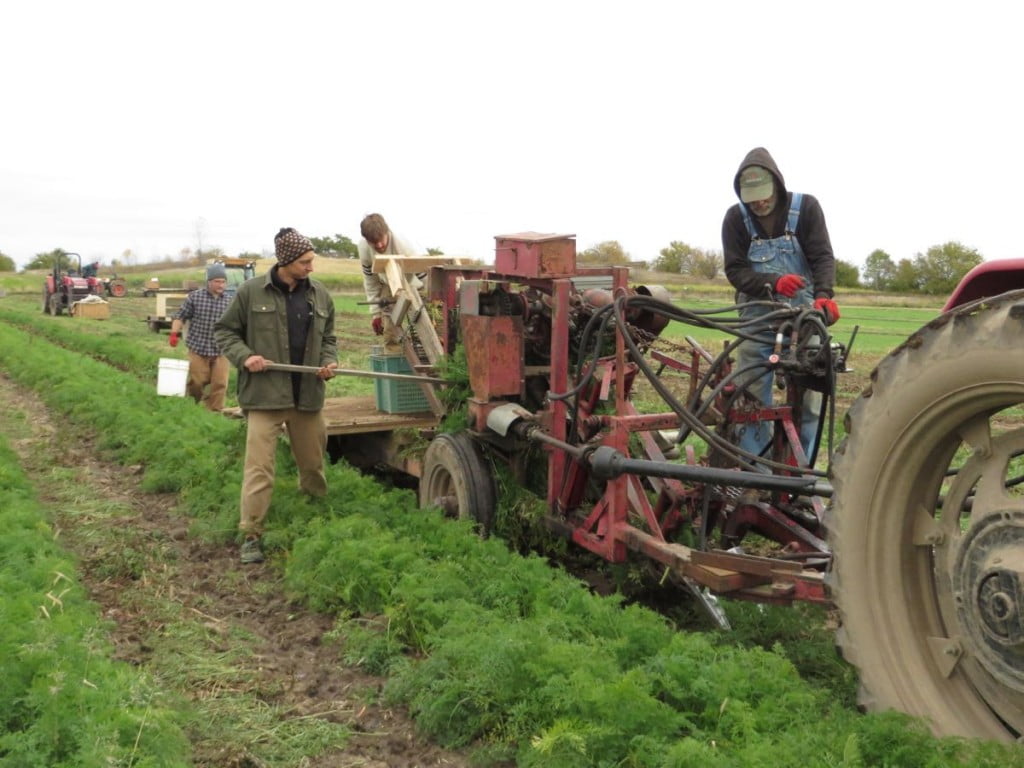
Carrot harvest is a team effort. From right, Steve steers the carrot harvester, Billy tends the harvested carrots, Tristan keeps the carrot tops flowing out of the harvester, and Joel picks up missed carrots. In the background, Larry and Michael haul bins of carrots back to the cooler. Simone is driving the tractor pulling the harvester, just out of the picture.
Our storage harvests are underway. The warm, dry weather is a gift. We are steadily stashing away celeriac, carrots, parsnips and turnips. We’ll start on cabbage and beets soon. These are important harvests for us. Steve is nervous as he goes over the preparations. “What if the harvester breaks? What if the cooler fails once it’s full?” This is very telling – Steve is not a nervous guy. We have so much riding on these storage crops, which we count on selling all winter. The big concern is that the weather will turn wet and we won’t be able to harvest the roots before the ground freezes. It’s been many years since we left carrots in the ground. That’s a virtue of our sandy soils. Beth
Veggie list and veggie notes
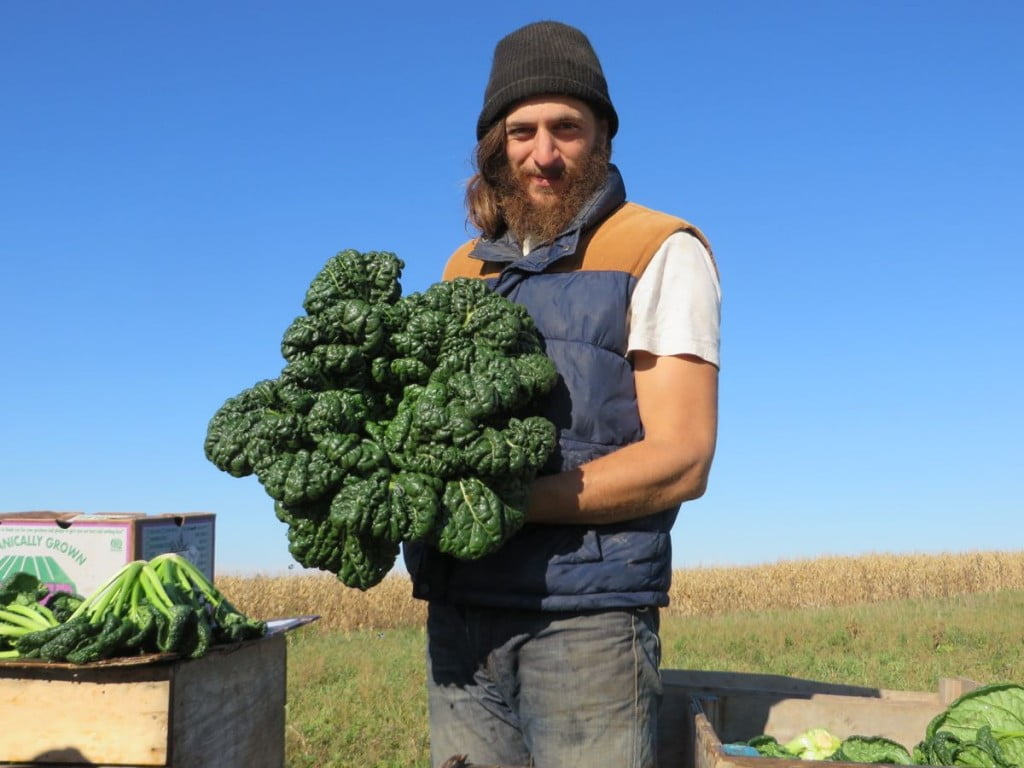
Don’t be frightened by the yukina. They look big but shrink substantially when cooked. Above, Clint holds a freshly harvested head of yukina.
Sweet potatoes, about 2 lb
Yukina greens, 1 large
Leeks, 1.5 – 2 lb
Russet potatoes, about 3.5 lb
Parsnips, 1.5 lb
Romanesco broccoli, 1 or 2 heads
Bell peppers, about 2
Onion, 1
Next week’s box will probably contain red cabbage, winter squash, broccoli, carrots, frying peppers, onions, garlic and more.
‘Beauregard’ sweet potatoes – Here are a few things we’ve learned about sweet potatoes:
– Store your sweet potatoes at room temperature. They suffer chilling injury below 50 F.
– The sweet potatoes we grow require slightly longer cooking than ones from the supermarket, perhaps because they contain higher moisture so soon after harvest. Cook thoroughly for best flavor and texture.
– Sweet potatoes are good at any size. We have cooked everything from tiny to jumbo and consistently find that all sizes taste good.
– We have a new favorite way to roast sweet potatoes. We used to prepare sweet potato fries. Now we just quarter the potatoes, rub with olive oil, dust with salt and place cut-side-down on a cookie sheet. Roast in a 450 F oven without turning until soft. The flavors will caramelize (like sweet potato fries) but preparation is simpler and the cooking time less exacting. Slender sweet potato fries go from undercooked to overcooked in the blink of an eye.
Parsnips (tapered, cream colored roots) – Those long, white roots are not carrots, they are parsnips. The two vegetables are related. When cooked, parsnips are sweet and starchy. For the best flavor, brown them to caramelize the sugars. Here are a few ideas for parsnip preparation:
– Caramelize the parsnips by roasting them in a vegetable medley.
– Parsnip fries are delicious: cut like French fries, coat very lightly with oil, place on a cookie sheet and roast in a hot oven until brown and cooked through.
– Try substituting grated parsnips in a potato pancake recipe. They brown beautifully and are very tasty.
– Steve loves pan-fried parsnips with onions and garlic.
Yukina (large heads of dark green leaves) – This is my favorite fall green. It is nutritious, delicious, a great combination of mustard-like leaves with crunchy stems. Personally, I think it’s a better ratio of leaves to stems than bok choy. These yukina look big, but the average weight is just 1.5 lb, which tells you they will shrink once cooked. We usually steam and drain chopped yukina, then dress it with a cooked mixture of fried garlic simmered with olive oil, balsamic vinegar, soy sauce, a little sugar and a lot of paprika or hot pepper flakes.
See below for an interesting way to prepare yukina in the oven.
Spicy Roasted Yukina (or bok choy)
This is an interesting way to tackle any voluminous tender green like yukina or bok choy. We made a batch and enjoyed it first as a hot dish, then as a cold salad.
1 large head yukina or bok choy
2 Tbsp. olive oil
1.5 Tbsp. sesame oil
4 Tbsp. soy sauce or tamari
1.5 Tbsp. rice vinegar
3 cloves garlic, minced
2 tsp. red pepper flakes (less if you don’t like spicy food)
2 Tbsp. toasted sesame seeds
1. Preheat oven to 400 oF.
2. Cut the yukina in half lengthwise. Cut stems and leaves into ribbons. Wash well and drain. Shake well to remove excess water.
3. Stir together all the remaining ingredients.
4. Spread the yukina on one (or two) large cookie sheets. Pour the marinate over the yukina and toss with your hands.
5. Roast until wilted and tender-crisp, about 10 – 12 minutes.
6. Toss again. Adjust marinade to taste. Serve.
Let’s review our schedule
- On: October 15, 2014
 0
0
We have four more CSA deliveries after this week:
October 16/17 (this week) – purple EOW
October 23/24 – green EOW
October 30/31 – purple EOW
November 6/7 – final box for green EOW members
November 13/14 – final box for weekly members and purple EOW members
We will contact our storage share members directly with the delivery date for that share. Our storage shares are sold out.
New Madison-area CSA site in 2015?
We would like to open one additional CSA site in the Madison area next year, in a neighborhood or a workplace. We are particularly interested in working with current Tipi members. Wouldn’t it be convenient to have your CSA box delivered directly to your neighborhood or workplace? Read more here, and contact us if you are interested.
Farm News
It’s been a wet week but we keep working, even when it rains.
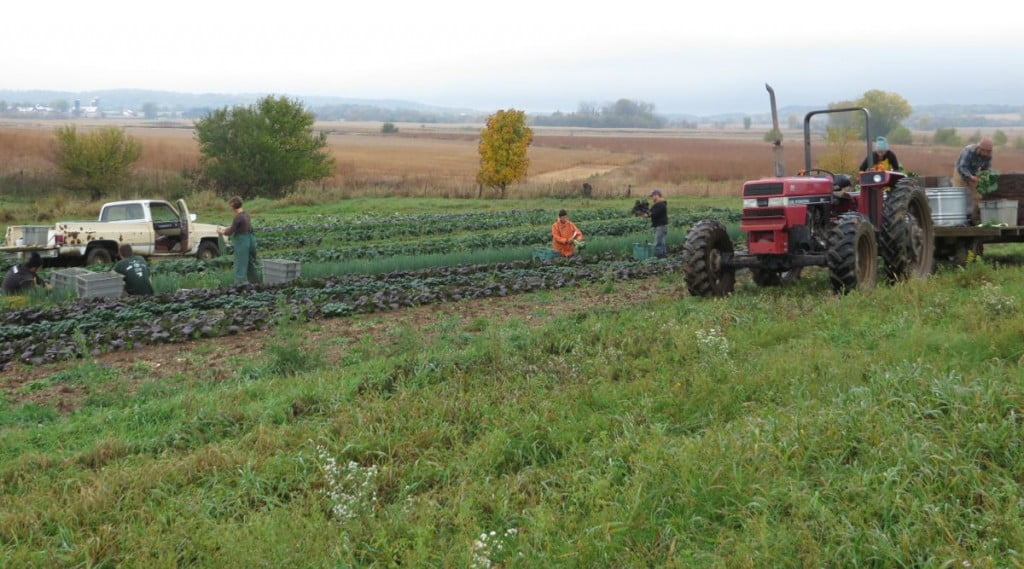
We hurried to complete our field harvests during the dry spells. From left, Mario, Tristan and Kerry harvest scallions, while Jon and Joel harvest bok choy. Bonnie and Michael wash the choy on the wagon. This field overlooks our neighbors’ soybean field and their large prairie planting.

Steve hopes it does not rain again until after Thanksgiving. Even our sandy soils turn to mud after 2.5 inches of rain.
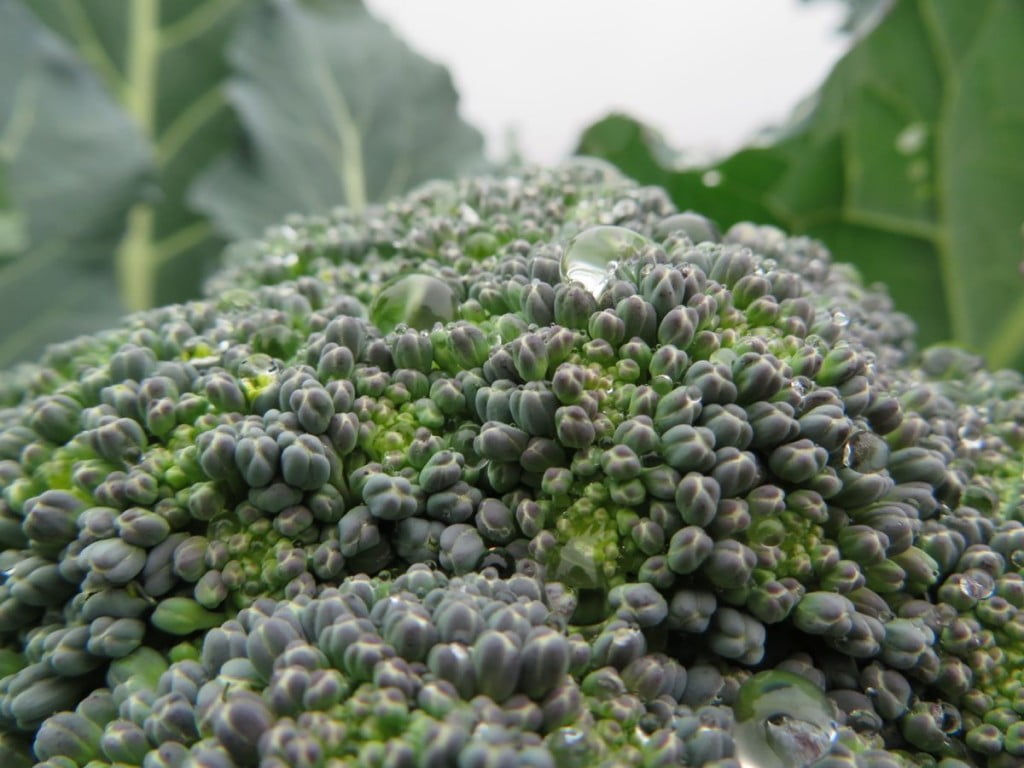
Good thing broccoli is waterproof.
Veggie list and veggie notes
We will pack mixed veggies that you can combine in Asian-style dishes; bok choy, daikon radish, scallions, garlic, ‘mild’ chiles with lots of flavor. You can stir-fry these these ingredients together, or make an excellent fresh kimchi salad. Steve points out that “every dish at a Chinese restaurant includes celery”, so perhaps you will add the celery to this list.
Bok choy, 1
Daikon radish, about 1 lb
Scallions, 1 bunch
Garlic
‘Mild’ habaneros, a handful
Cauliflower OR broccoli
Celery
Winter squash
Bell peppers, about 2
Yellow onions, 2
Next week’s box will probably contain sweet potatoes, Yukina greens, russet potatoes, peppers, Romanesco broccoli, onions, carrots, and more.
Bok choy – You will receive either red or green bok choy.
Daikon radish – Finally, we have daikon for you!
‘Mild habaneros’ – These ‘mild’ habaneros are pretty interesting. They do have heat, about the level of a typical Anaheim or poblano (not this year’s poblanos which are unusually mild). These habaneros are useful because you get manageable heat with really great flavor. We are sending about 4 per box.
Celery – You will probably want to cook this celery because it is strongly flavored, and has some insect scarring. We experimented with our one annual celery planting this year. We planted later than usual so it would mature in cool weather and be more tender than celery harvested during the summer. It sort of worked. This celery is more tender than in other years. However, planting later created more opportunity for insect attack. Look it over, taste it raw, and decide how you want to use it.
Winter squash – You will receive either butternut OR Sunshine OR acorn OR Sweet Dumpling. See below for photo ID and hints for cooking Sunshine squash.
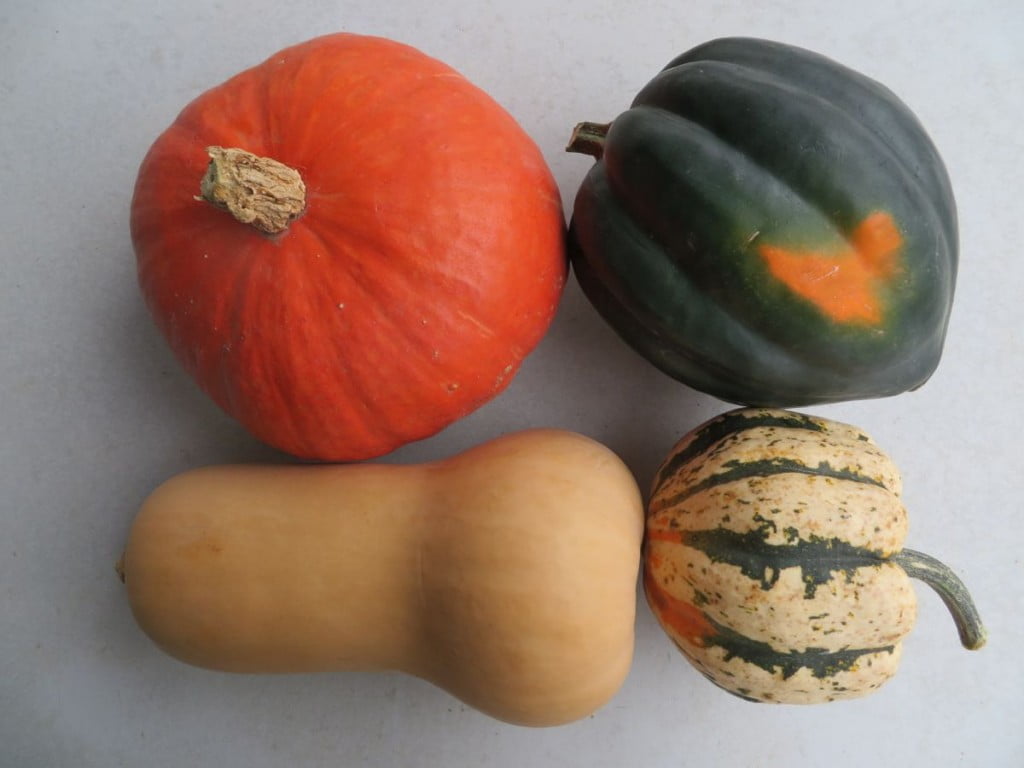
Squash ID. Clockwise from top left, Sunshine, acorn, Sweet Dumpling, butternut.
Notes on Sunshine squash
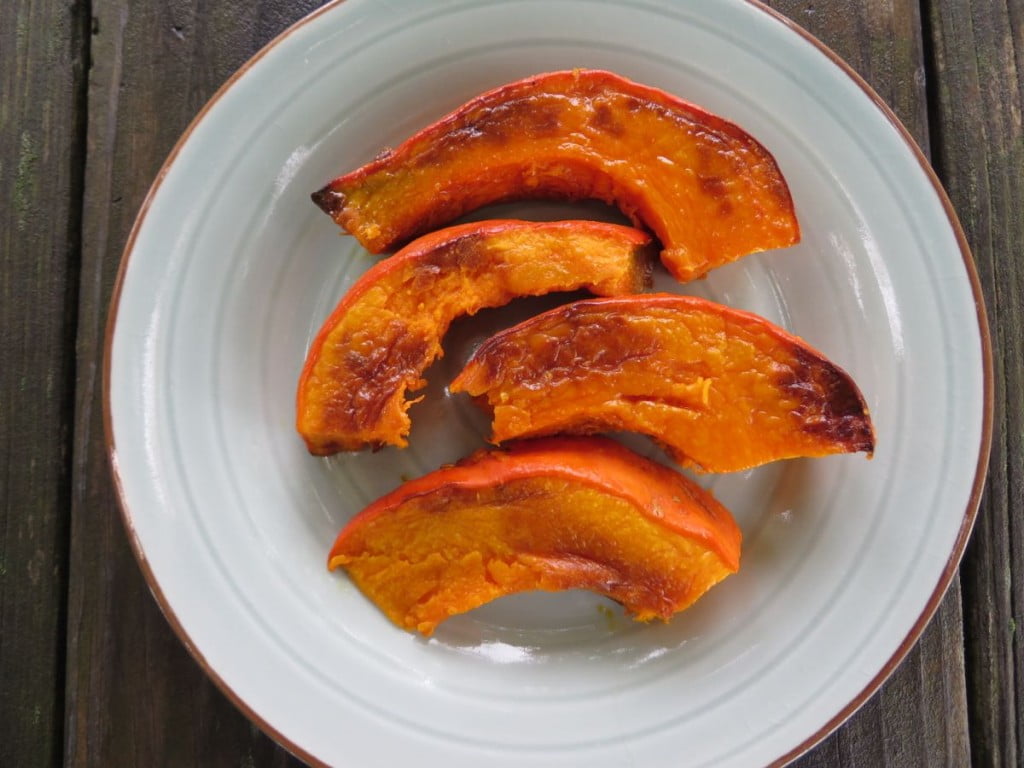
Roasted Sunshine squash slices
This is the first year we’ve had many Sunshine squash to distribute. These bright orange squash have a dry texture when cooked, with a mild, sweet flavor reminiscent of chestnuts. The skins are tender and edible. We find that Sunshine do not store well, probably because of the thin skins. Eat these soon. Like all winter squash, they are best stored at room temperature with good air circulation. On your kitchen counter is perfect.
Now that we finally have some to cook (!) I’ve settled on a favorite simple preparation. Dry roasting seems the best way to bring out their delicate flavor. Cut the Sunshine into thick slices, toss with olive oil, and roast on a well-oiled cookie sheet at 425oF until soft. The slices will fall apart if you overcook them but you have a fairly wide window to get them out of the oven successfully. You want to roast them until the cut surfaces are caramelized. Season with salt after they are out of the oven. Serve with a yogurt-garlic-olive oil dip. The skins are edible.
Squash (or Sweet Potato) Muffins with Candied Ginger
Adapted from Deborah Madison’s Vegetarian Cooking for Everyone.
Make 12 muffins.
Beth’s note: This is a great way to use leftover roasted winter squash or sweet potatoes.
1/2 cup candied ginger, dried cranberries or raisins, or a mixture
(plus extra candied ginger to top the muffins.)
1/4 cup vegetable oil
1/3 cup unsulfured molasses
1/2 cup packed brown sugar
1 cup mashed cooked winter squash or sweet potato
2 eggs
1/2 cup buttermilk (see substitution)
1 3/4 cup whole wheat pastry flour
1 tsp. baking powder
1 tsp. baking soda
1/2 tsp. salt
1 tsp. cinnamon
Preheat the oven to 375oF. Oil or spray your muffin tin.
Mix the ginger and wet ingredients in a bowl until smooth. Mix the dry ingredients together separately. Combine the two, and mix gently until well blended. Spoon the batter into the muffin tin. Top each muffin with a bit of candied ginger. Bake on the middle shelf until lightly browned, 25 minutes.
Soy substitution for the buttermilk: Mix 1/2 cup soy milk with 1 1/2 tsp white vinegar. Stir and let sit for 5 minutes.
Gleaning fun
- On: October 08, 2014
 0
0
The pumpkin and gleaning party was a big success. Members visited to enjoy the perfect weather, pick pumpkins and glean a few vegetables. There were loads of pumpkins to choose from; it was a strong, healthy crop this year. The day was very enjoyable for Steve and I, a chance to hang out with the people we’ve fed all year. I’ve posted additional photos on our Facebook page, labelled #tipiglean14.
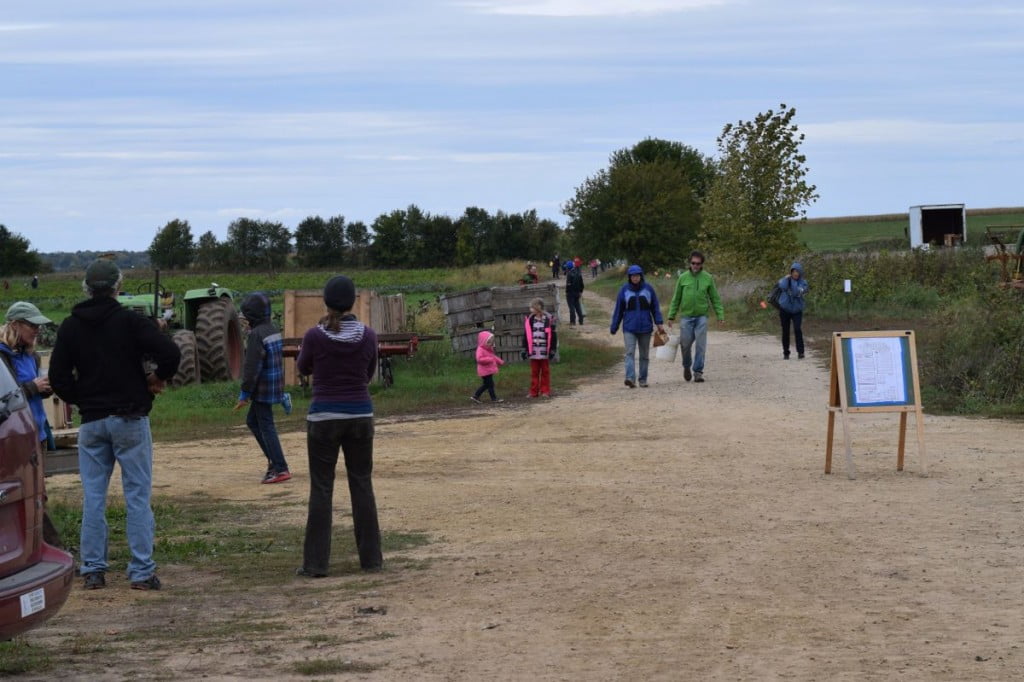
Members wandered across the farm, reaching the furthest corners of the farm. I think Steve included a few distant fields in the gleaning list for just that reason.
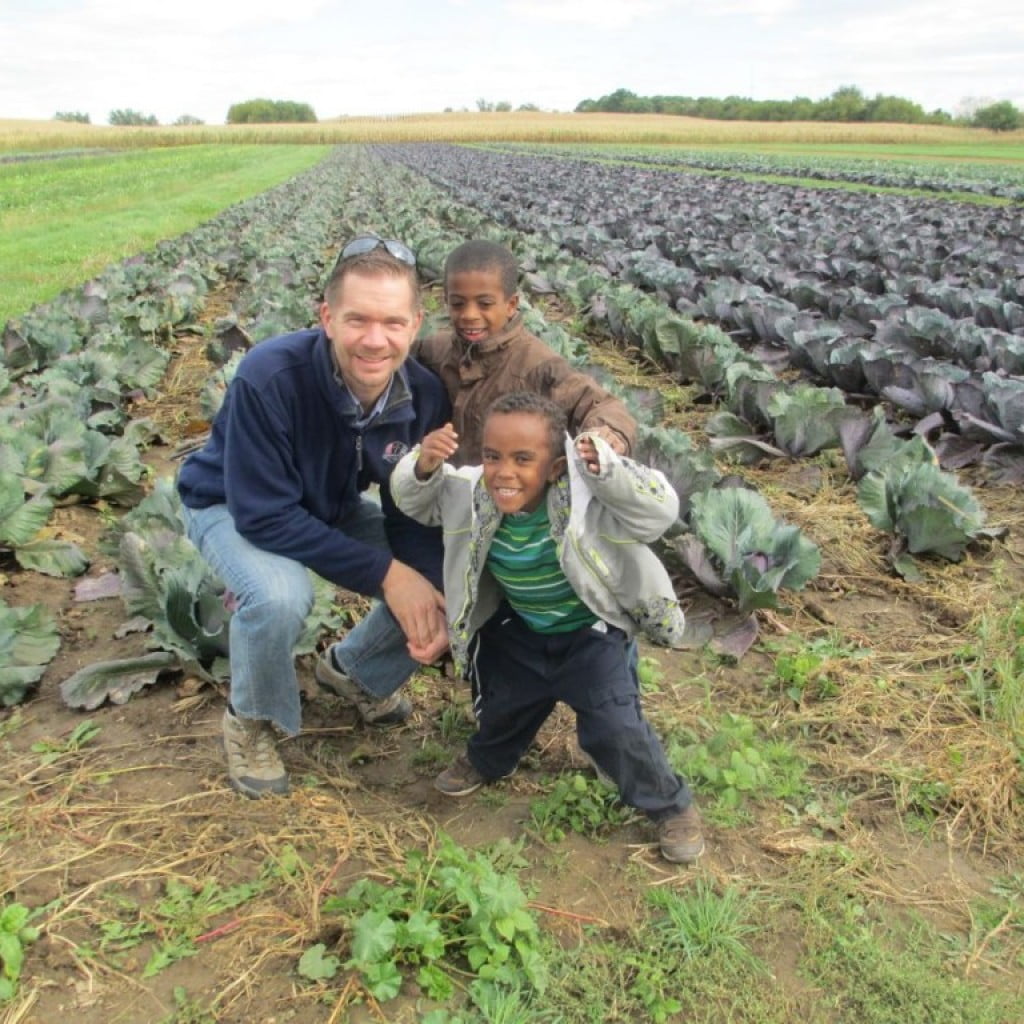
It was a family outing for many.
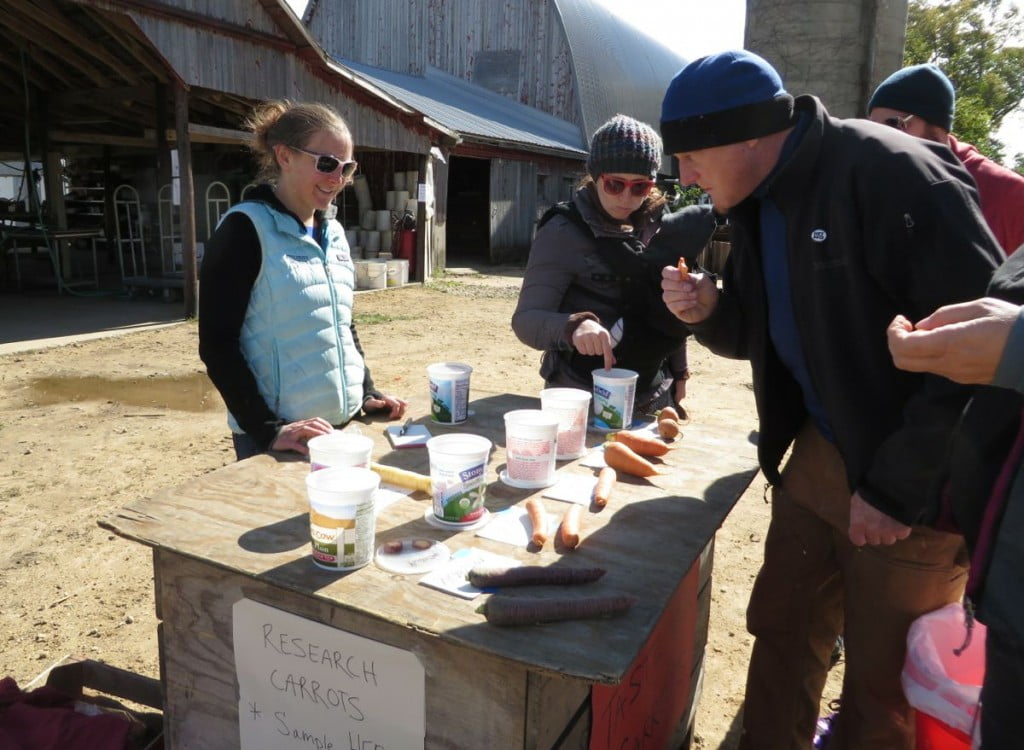
UW graduate student Claire Luby offered samples from her carrot research trial which she just finished harvesting. I’ve written before about Claire and Irwin Goldman’s research plots at our farm.
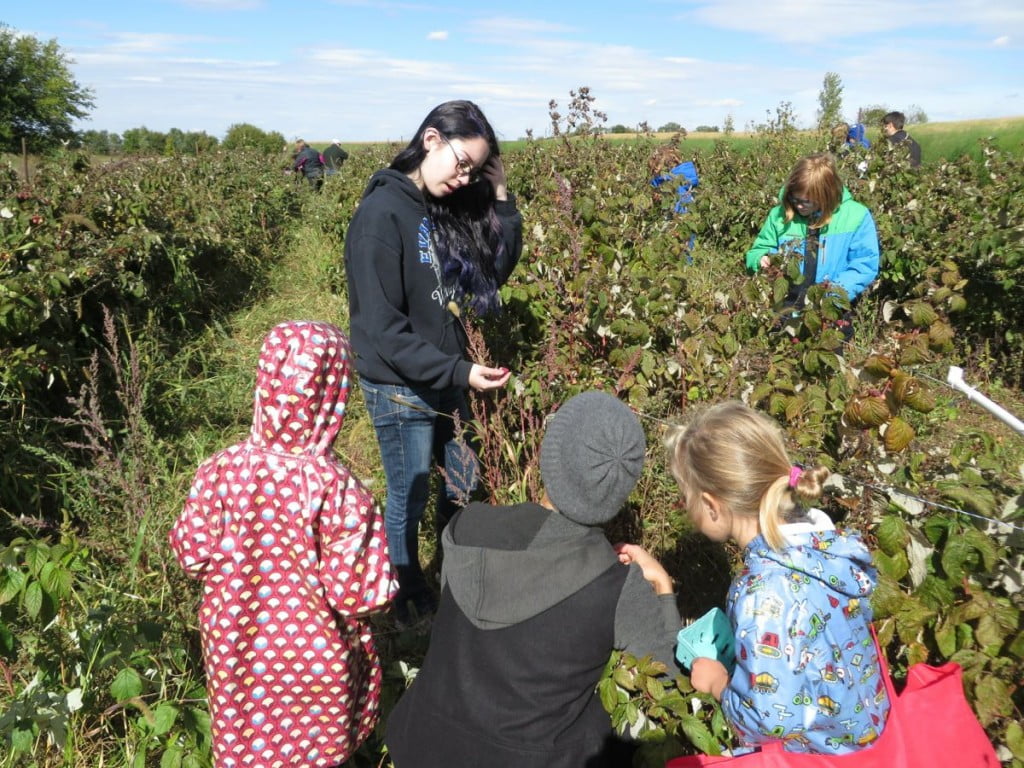
Our daughter taught members how to find good raspberries. The fruit flies are not too bad right now, so persistent (and patient) members could find good berries.
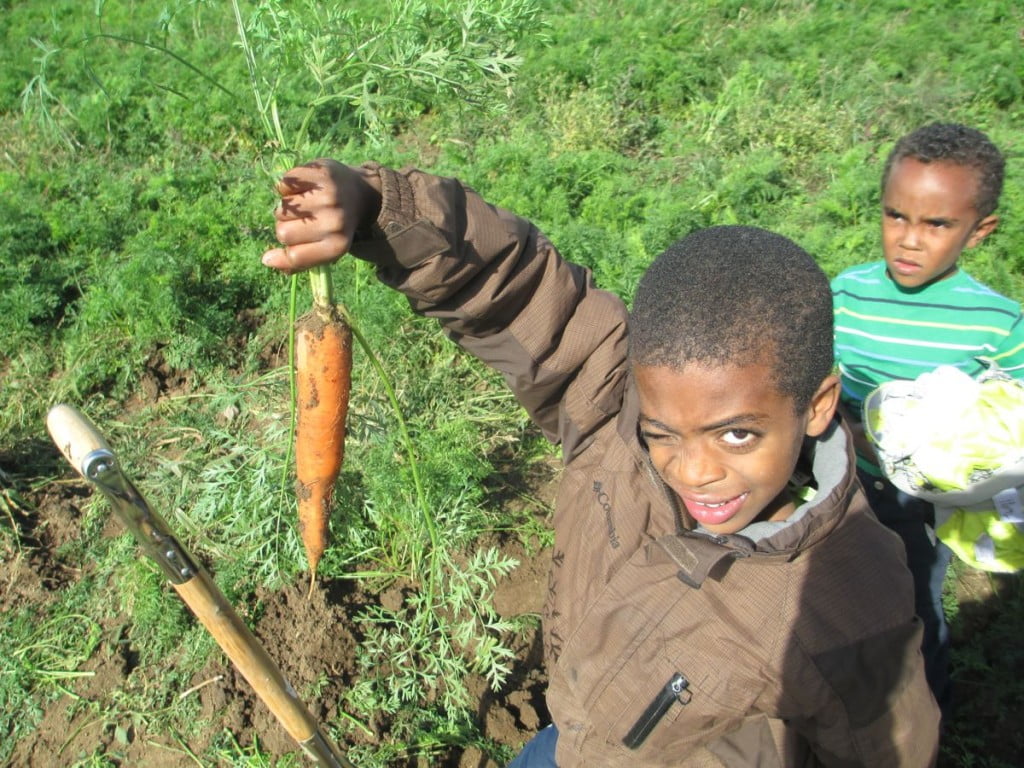
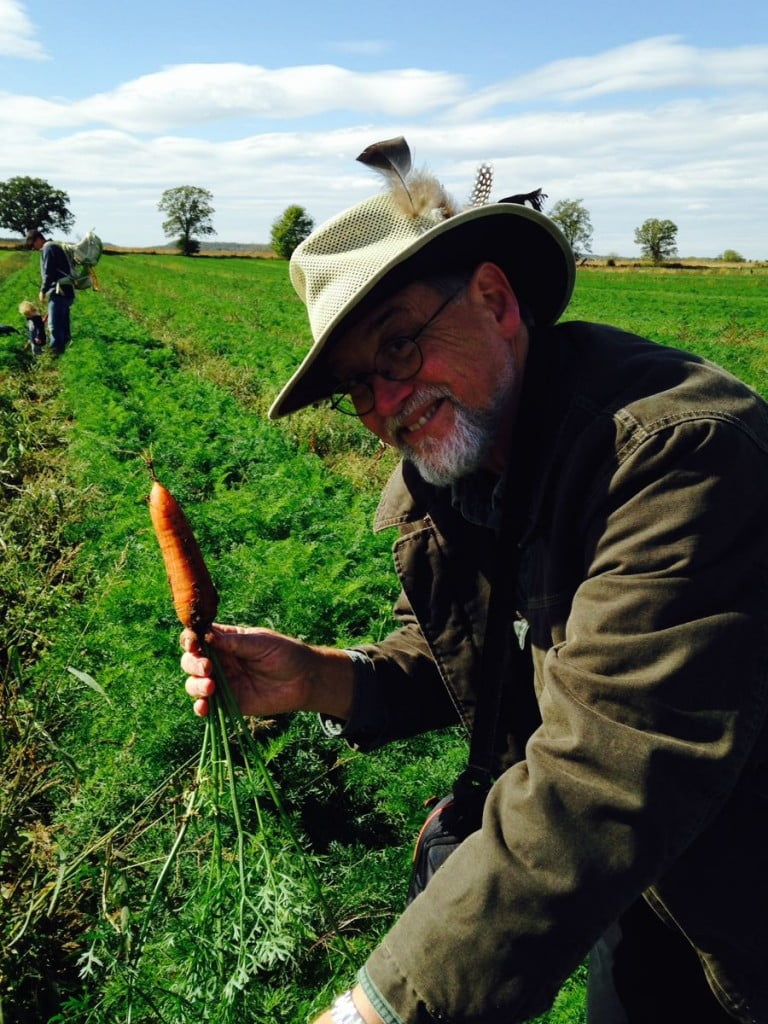
The thrill of digging up a big carrot!
I enjoy seeing our farm through our members’ eyes. Julie Garret took the lovely photos below.
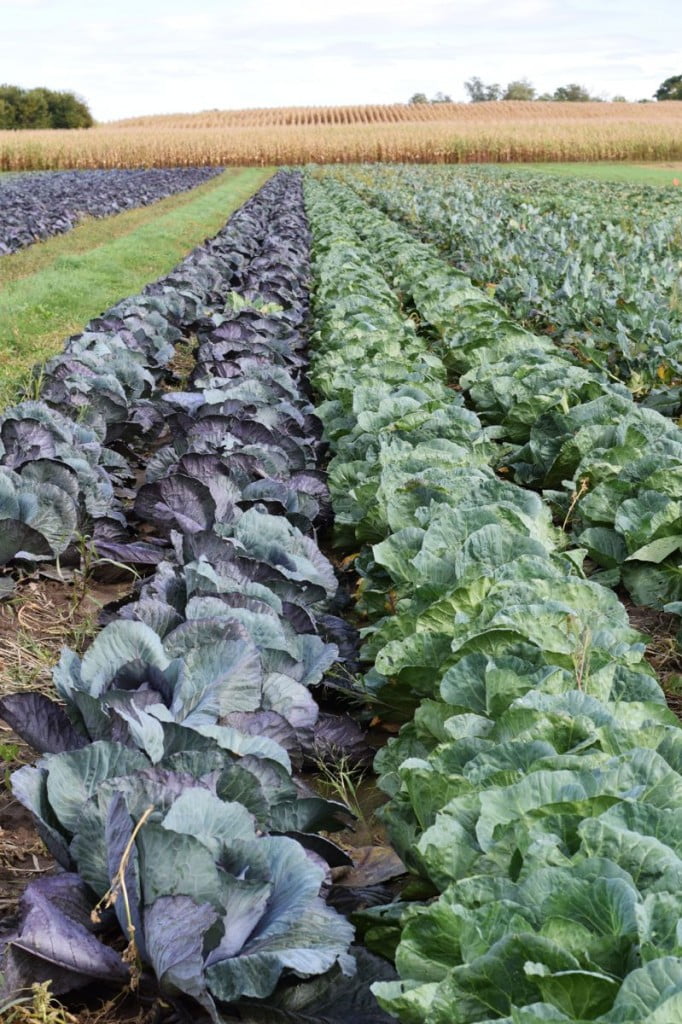
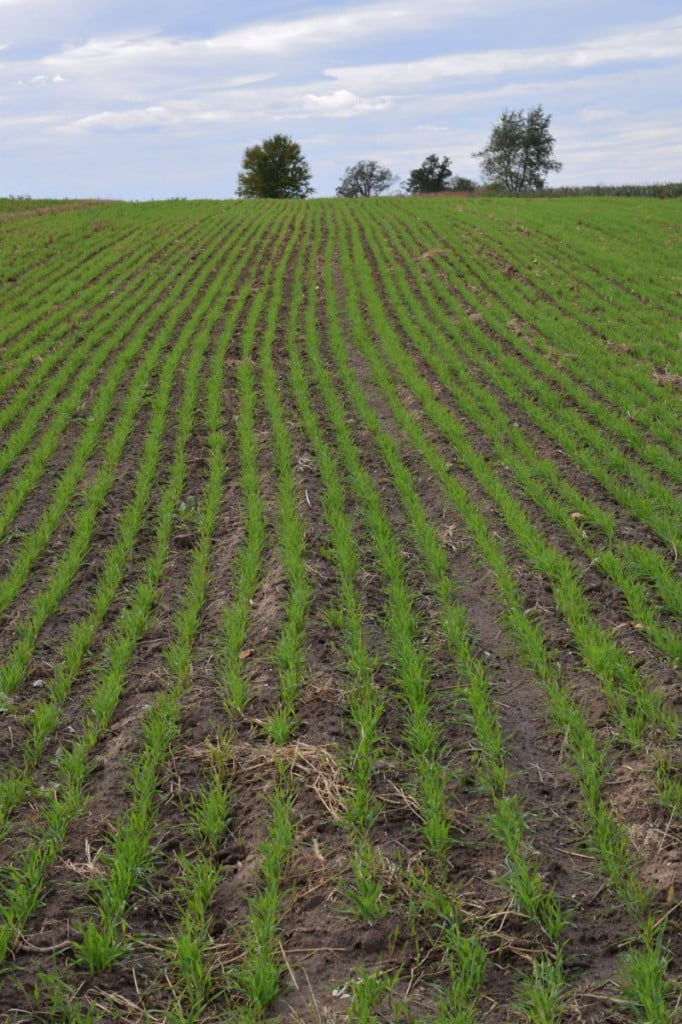
Thanks to everyone who shared their photos with us.
Veggie list and veggie notes (10/9/14, week #21, green EOW)
It’s been a busy week for us. All our winter squash and sweet potatoes are safely harvested. That feels good. I’ll post photos of the harvests next week. We hope you enjoy this pretty box of veggies. Everything is so vibrant right now. We plan to send lots of winter squash in the remaining boxes, especially butternuts which are so versatile for cooking. See below for a favorite butternut recipe.
‘Metro’ butternut squash, 1
Cauliflower
Golden beets with greens, 1 bunch
Eggplant, globe or Japanese
Carrots, 2 lb
Bell peppers, 2
Anaheim chiles (hot), 2
Yellow onions, about 2
Parsley, 1 bunch
Next week’s box will contain winter squash or sweet potatoes, bok choy or cabbage, scallions, garlic, onions, daikon radish, peppers and more.
Butternut squash (tan, long) – These are the ‘Metro’ variety, a favorite because it cures and sweetens quickly after harvest. These are medium-sized squash, average weight 2.0 to 2.5 lb.
Eggplant – We finally have eggplant to share. It has been a difficult year for eggplant due to season-long insect attacks. The plants set a late crop. We’re glad they are ready to harvest before frost. By this time of year, the eggplant may be seedy.
Anaheim chiles (long, slender, red, green or mixed red and green) – These are hot peppers. Anaheims usually have medium spiciness although it varies from pepper to pepper. As usual, the heat is concentrated in the seeds and midveins. Remove the seeds and midveins is to lessen the chili’s heat. Anaheims are easily mistaken for Italian frying peppers. We never send them in the same box for that reason. Keep this in mind if you have frying peppers left over from last week.
Golden beets with greens – Beet greens are delicious. They are similar to Swiss chard in flavor, texture & cooking time (the two crops are very closely related.) You can remove the thickest midribs before cooking if you wish, but it is not essential.
Storage: Cover and refrigerate. The beet roots will last for weeks. Beet greens are perishable and should be eaten soon. Separate the tops and roots if you don’t plan to eat the greens immediately, to preserve freshness in the roots.
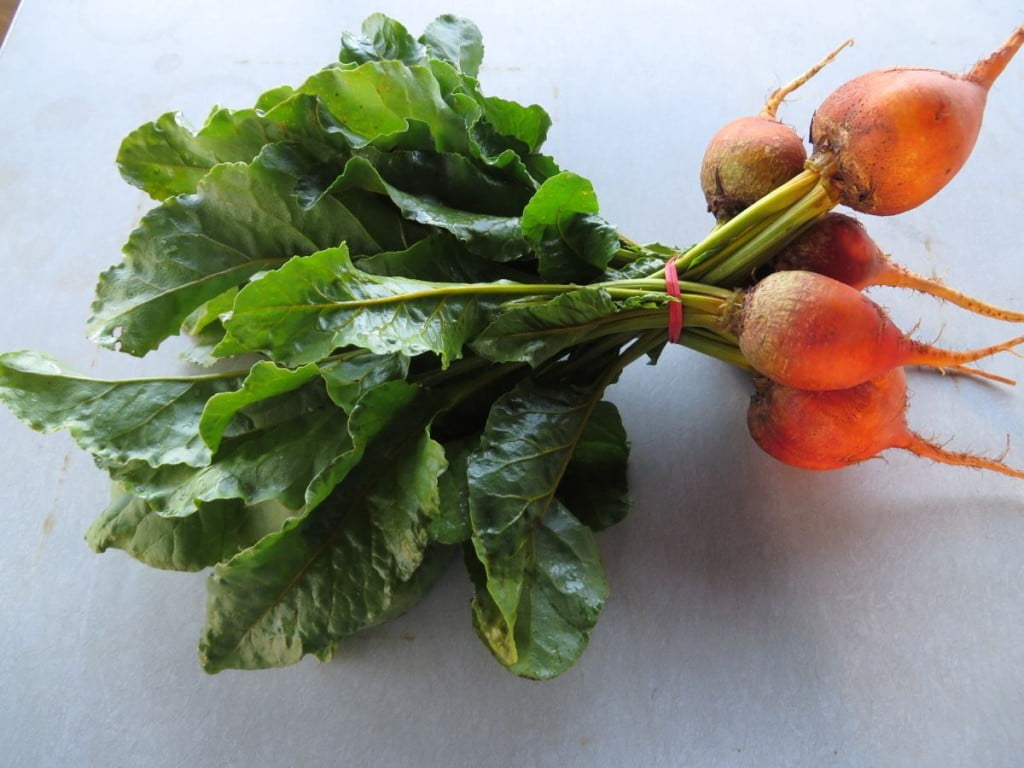
Masala Winter Squash
Mark Bittman, ‘The Best Recipes in the World.’ Serves 4. Time: 40 minutes.
Beth’s notes: This is a lively dish with lots of flavor. It’s OK to skip the tomatoes unless you have a few in the freezer; just add lime juice at the end to replace the acidity. Add the lime juice bit by bit – it doesn’t take much. Serve with rice. Mark Bittman writes this is a “lovely winter stew that can be a centerpiece for vegetarians (or for meat eaters with the addition of a few cubes of boneless chicken).”
1 large onion
5 garlic cloves, peeled
1 small dried chile or 1 tsp hot red pepper flakes, or to taste
2 Tbsp. corn, grapeseed or other neutral oil
salt and black pepper to taste
1 Tbsp. curry powder, or to taste
1 cup chopped tomato (canned is fine), optional
about 1 ½ lb winter squash, like butternut or firm pumpkin, peeled and cut into 1-inch cubes
lime wedges for serving
1. Combing the onion, garlic and chile in a food processor and grind until pasty. Put the oil in a large skillet or flameproof casserole with a lid over medium heat and add the onion mixture along with some salt and pepper and the curry powder. Cook, stirring occasionally, until the onion begins to brown, 5 to 10 minutes.
2. Add the tomato or ½ cup water along with the squash. Cover and adjust the heat so the mixture simmers steadily. Cook, stirring occasionally (and gently) and adding more water if necessary, until the squash is tender, about 20 minutes. Serve with the lime wedges.
Our newest tools
- On: October 01, 2014
 0
0
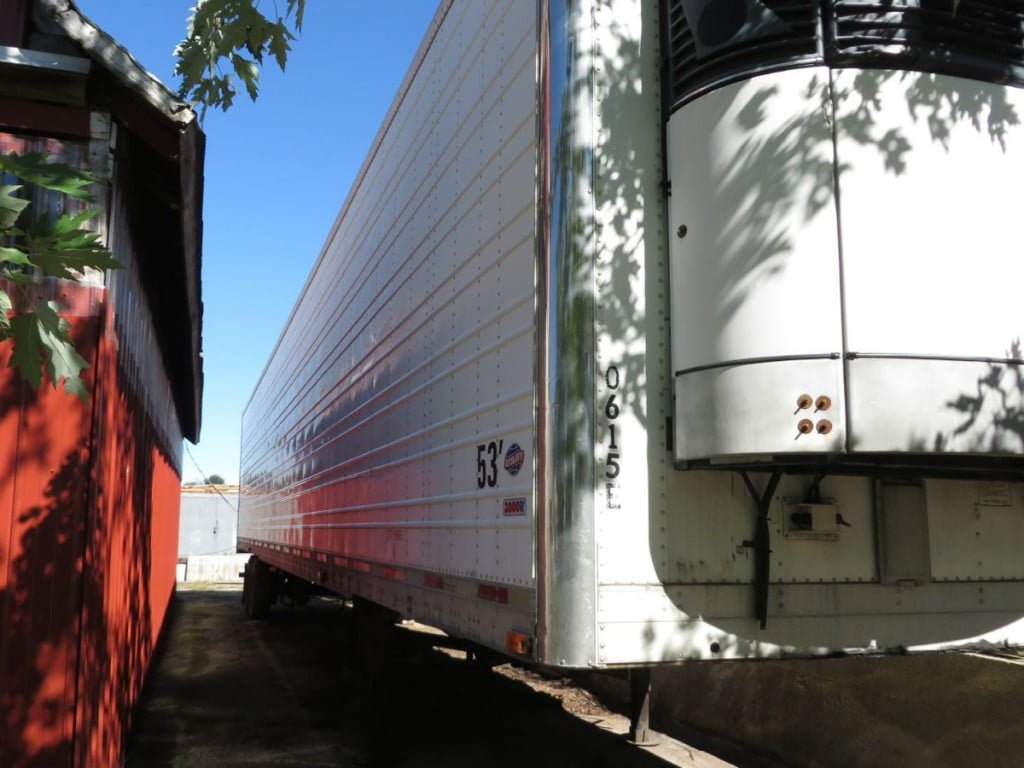
Our own semi-trailer, parked next to our red box barn.
Steve is working to upgrade our root storage and washing before the big fall harvests begin. Our winter root crops look abundant, more than we can fit in our current coolers. Several years ago, we stored part of our carrot crop in a cold storage facility in Madison, but that created transportation hassles. The solution? We bought a used refrigerated semi-trailer that was ready to retire from the road. It’s 53 feet long and can hold about 50,000 lb of roots in big wooden bins. No more running back and forth to Madison to retrieve carrots to wash at the farm, then ship back to Madison. I’ll post photos later this fall as we fill the trailer.
We are also in the midst of upgrading our root washing equipment. This is a big deal for us. We wash and sell 60 to 70 tons of roots through the winter, so our crew appreciates any improvements. Our goals are to ease the physical labor involved, and to find equipment that’s easy to clean. Our newest tool is a barrel washer from a Mennonite group in Pennsylvania. We’ll use it to wash carrots and other roots.
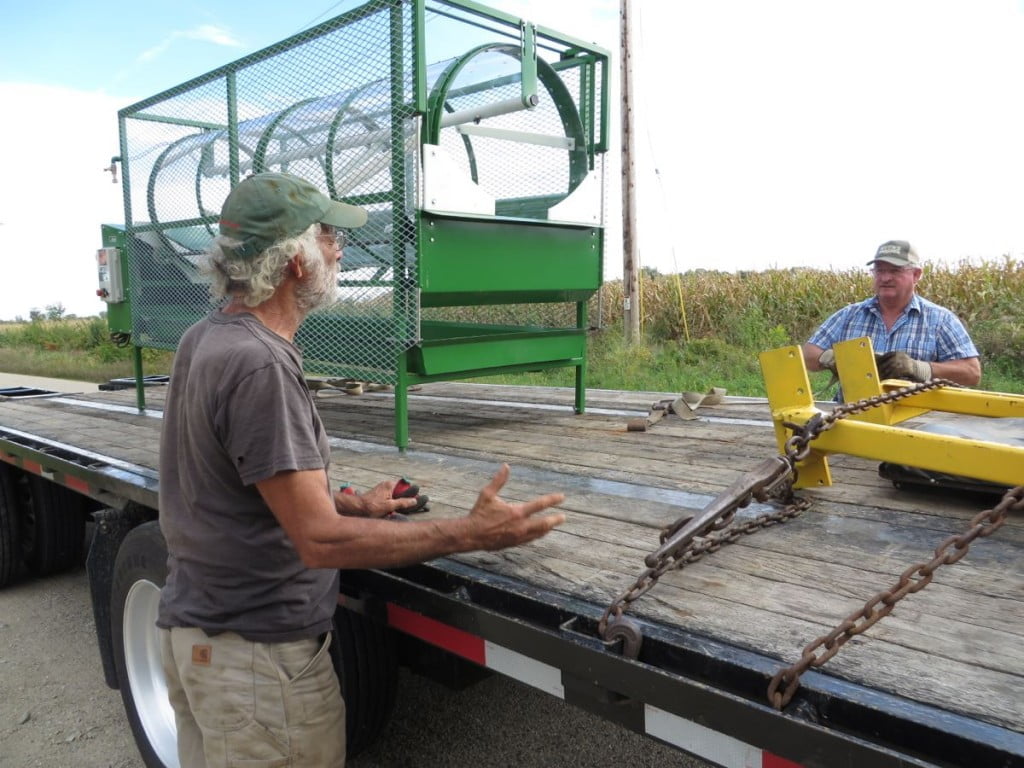
Steve with Mark Roeters who sold us the new barrel washer. They caught up on gossip about who-bought-what new farm equipment. Mark sells and delivers throughout the USA, so he knows everyone’s equipment.
Steve is very absorbed in these preparations. Evolving plans for the new washing setup are scattered in our office and kitchen. His gaze wanders back to the trailer, which keeps popping up in conversation. “You know, that trailer will be great storage for our empty bins. It will really free up space in the barn” or “I might add an extra layer of insulation, just in case.” We don’t have much time before the weather turns cold.
Farm news and Veggie list (10/2/14, week #20, purple EOW)
Our cabbage-family crops are growing strongly. Almost all our broccoli, cauliflower and Romanesco are harvested or will be ready in the next two weeks. This is not normal. Often, the cauliflower and Romanesco barely mature in time for our final CSA deliveries. We’re glad to have these crops for the CSA boxes now, but we have to recognize that we will not have much broccoli, cauliflower or Romanesco in late October and early November.
Yellow potatoes, 3.5 lb
Romanesco broccoli, 1
(We’ll send a broccoli head too if your Romanesco is small)
Acorn squash, 1
Delicata OR Sweet Dumpling squash, 1
Leeks, 2 lb
Carrots, 2 lb
Frying peppers, mixed colors, about 3
Jalapeño chiles, 2
Cilantro, 1 bunch
Garlic
Next week’s box will probably contain cauliflower or Romanesco, winter squash, peppers, onions, carrots and more.
Romanesco broccoli (pale green conical head, possible tinged with purple) – This is one of our prettiest vegetables. Look at it closely to appreciate its branched beauty and repeating spiral pattern. It is called broccoli, but is closely related to cauliflower which it resembles in flavor and texture. Like broccoli and cauliflower, it is fine eaten raw or cooked. It requires cooking times intermediate between the two. Don’t overcook it. I usually steam it, then dress it simply with a butter-lemon-garlic-mustard sauce.
Acorn squash – Acorn squash are mild and benefit from browning the cut surfaces to bring out their flavor. We like to cut acorn squash into slices, then roast or pan-fry the slices until they caramelize. Acorn squash are also good for stuffing. These are ‘Tip Top,’ our favorite acorn squash variety. We have tested many varieties over the past few years, and settled on this one as the best.
Jalapeño chiles (small, dark green or red) – These are hot.
Farm and raspberry news
- On: September 24, 2014
 0
0
We have enjoyed this week so, so much. An entire week of warm, dry weather at this time of year is a gift. Mud and rain complicate every task.
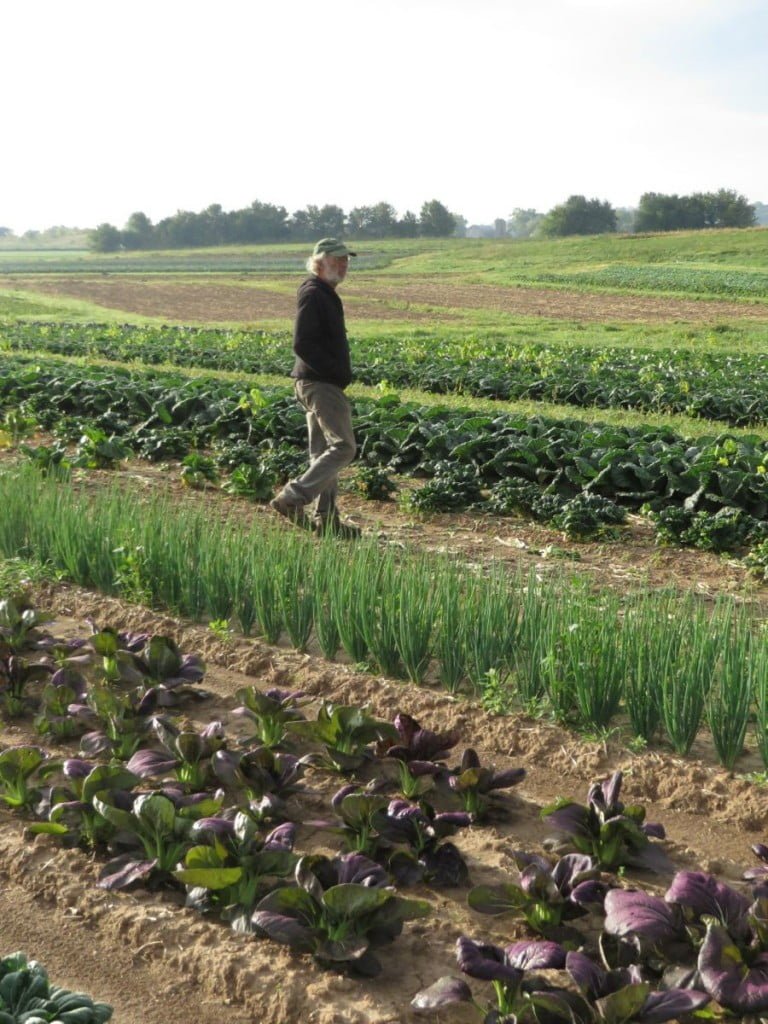
Steve walks the farm in the morning to make his harvest decisions. I love this corner of our farm. Unlike most of our flat fields, this area is a basin. Steve contours the fields, so they are all at different angles.
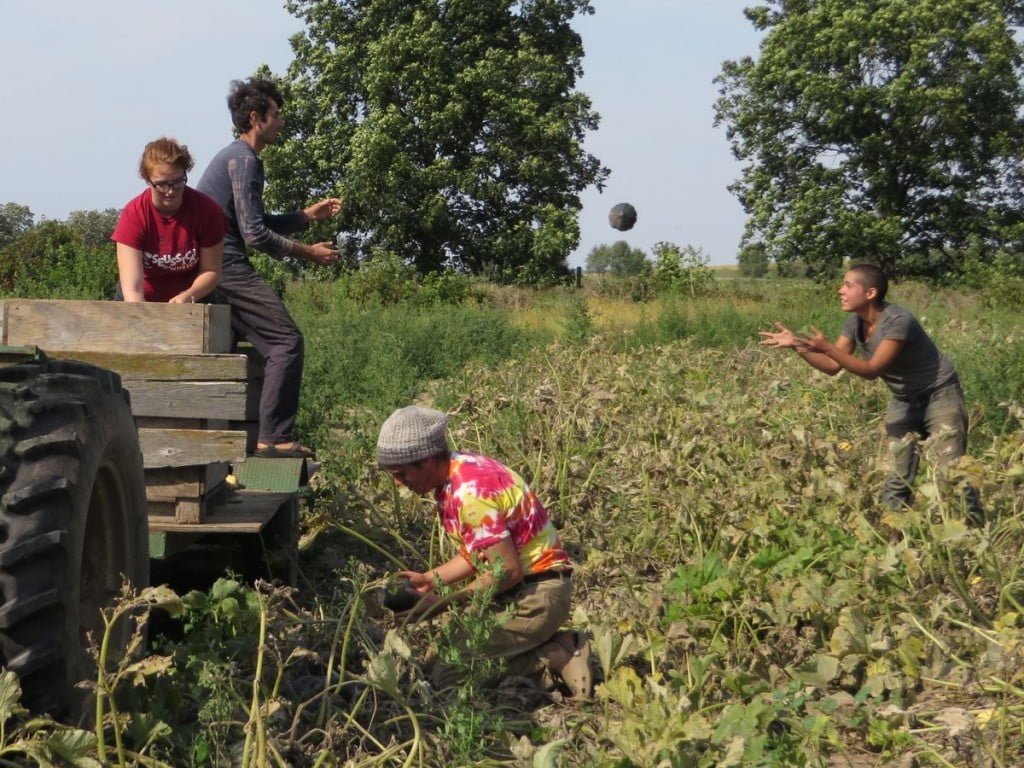
We are making progress with our winter squash harvests. All the Sweet Dumpling, delicata, acorn and Sugar Dumplings are tucked away. We’ve begun the butternut harvest, but there are many more to pick. It looks like a very good squash crop this year. From right, Boi tosses acorn squash, Jory clips the squash, Jon catches, and Caitlyn packs the acorns into wooden bins.
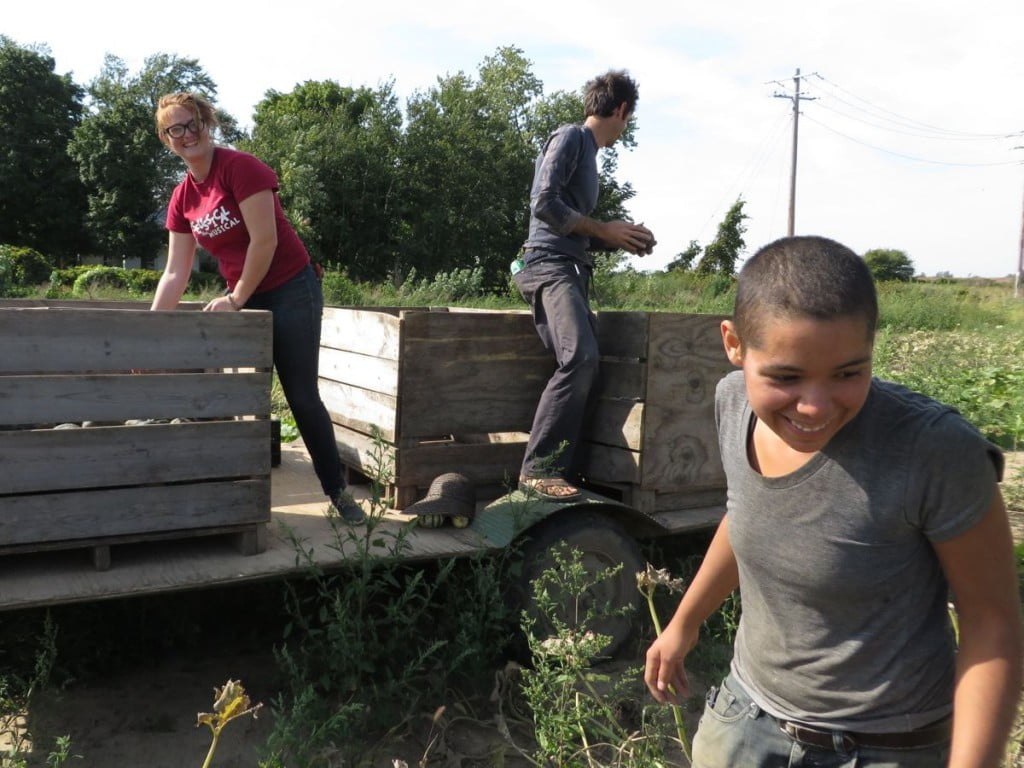
Our farm work is so enjoyable on warm days.
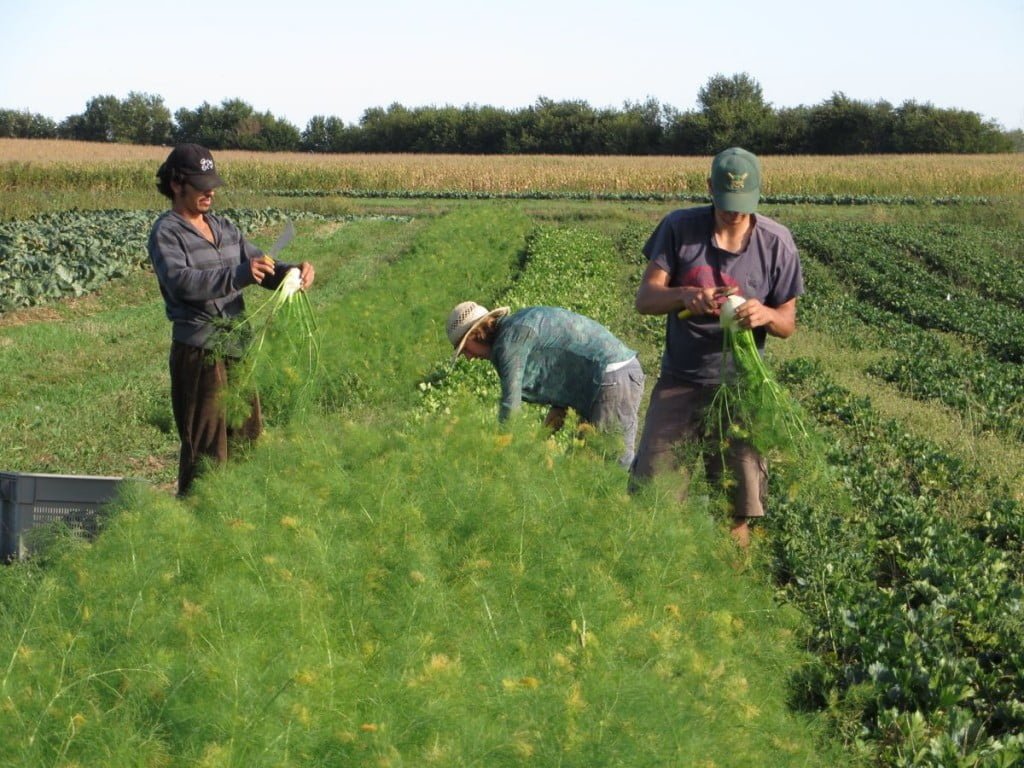
From left, Mario, Kerry and Tristan harvest fennel for your CSA boxes this week.
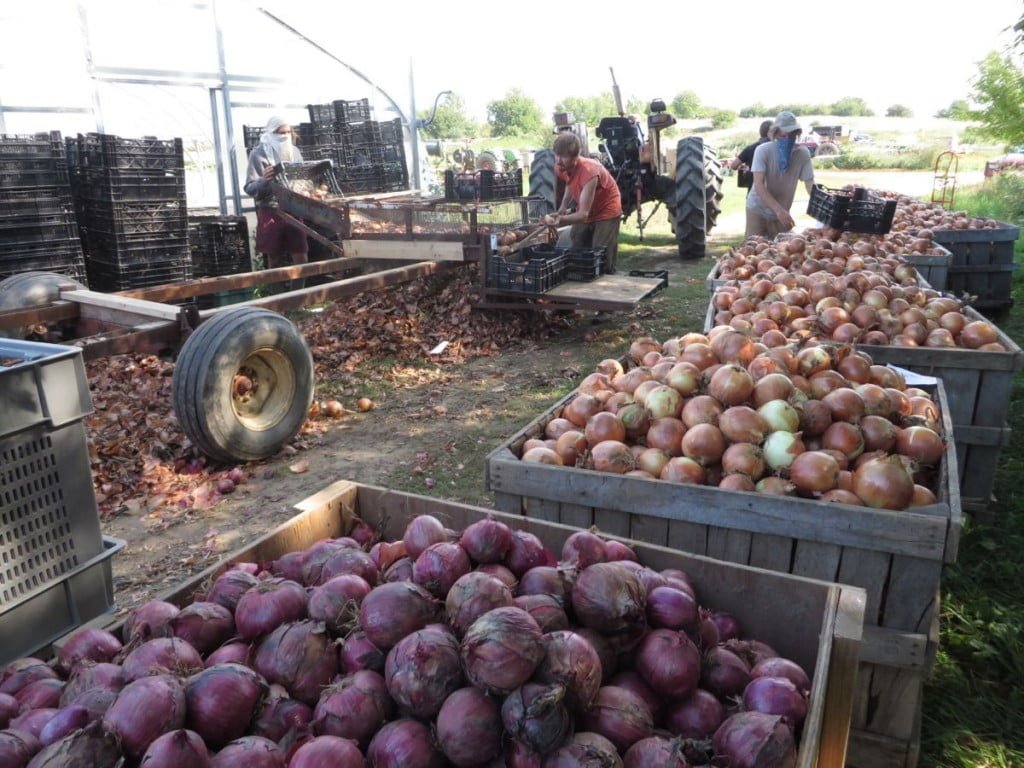
From left, Clint, Billy and Michael clean onions. We dry our onions in the greenhouse, then run them though a topper to remove leaves and loose skins, and knock off most of the dirt. It is a dusty job, so it’s great to take care of this step outside. Now the onions are stashed in our dry storage cooler.
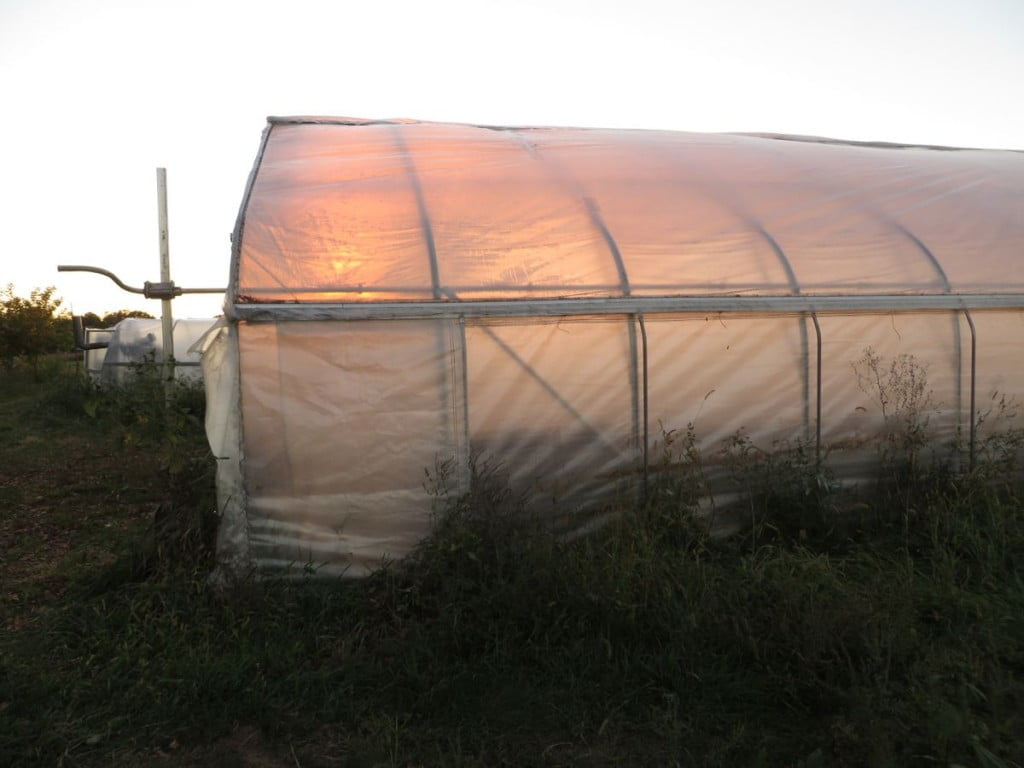
Sunset through the greenhouse.
Raspberry update
It is time to acknowledge that we will not have raspberries for the CSA boxes, nor will we host raspberry u-picks. Spotted wing drosophila (SWD) have wreaked havoc again this year. This fruit fly pest arrived in the USA in 2008, and in Wisconsin in 2012. We invested in growing a raspberry crop this year, but our techniques to control SWD failed. We are collaborating with UW entomologists again this year (and will next year too). So far, their studies have focussed on the fruit fly’s biology and behavior, as there are big gaps in basic knowledge about the pest. This past winter answered an essential question of whether SWD can survive our coldest winters. The answer is “yes.” Remember last winter’s Polar Vortex? The fruit fly survived without trouble.
At this point, our primary concern is learning enough about SWD to avoid risk to our strawberry crop too; the fruit fly showed up at the end of the strawberry season this year. We will grow raspberries again next year, and will try to control the fruit flies with cultural methods. Picking every berry is essential to controlling SWD. This can work quite well on a home garden scale. We plan to reduce the size of our field, narrow the rows, prune out early flowers and try our best to pick every berry. This is a tough situation for all raspberry growers and we are still learning how to manage this new pest.
We are disappointed that we couldn’t offer raspberry u-picks this fall. We will probably offer some berries to pick during the pumpkin and gleaning party. We’ll keep you posted. Beth
Earlier posting of the weekly veggie list?
A few members have asked us to post our veggie list earlier. I am now posting the week’s list in our website sidebar by about 7 pm Wednesday night. This is a few hours earlier than I have our newsletter ready. The sidebar “Box Contents” is visible on the right side of both our homepage and our farm newsletter page. I hope this helps.
Veggie list and veggie notes (9/25/14, week #19, green EOW)
Green cabbage
Cauliflower AND/OR broccoli
Fennel, 1 bulb
Green beans, 1/2 lb
Bell peppers, about 2
Red onion, 1
Yellow onion, 1
Slicing tomatoes, just a few
Poblano chiles, 3
Lettuce, 1 medium head
Garlic
Next week’s box will probably contain winter squash, potatoes, leeks, cilantro, peppers, carrots and more.
Fennel – We have trimmed away most of the fronds so the fennel will fit in the box. The plants stand three feet high out in the field. We’ve left the tender central fronds so you can chop and add them to cooked dishes for extra anise flavor.
Fennel is a ‘swing vegetable’; it can be used raw or cooked. Clean well and slice as thinly as possible for use in raw salads. It is good simply prepared with olive oil, lime or lemon juice, salt and shaved parmesan cheese. Cooking softens and sweetens fennel, and mellows its anise flavor. Both the bulb and leaves are edible. We’ve send the fennel in combination with the last few tomatoes because they are so good cooked together. I asked Pat of Local Thyme to come up with an interesting use this week.
Slicing tomatoes – We will send just a few tomatoes this week. The tomato season is nearly over. These late season tomatoes are a bit soft and will not store for very long. Eat them up. Personally, I prefer to cook late-season tomatoes, rather than prepare them raw.
Poblano chiles – The flavor of the poblanos is quite good this year. As I wrote a few weeks ago, these chiles are unusually mild this year, with occasional hot ones mixed in. Remove the seeds and midveins to reduce the chance of heat. Taste a sliver. Use your best judgement.
Lettuce – This is the last lettuce of the year!
Youthful energy
- On: September 17, 2014
 0
0
Every day, our work crew carries us forward with their youthful energy. Maggie and Clint organized a Tipi contingent for the Willy Street parade this past weekend. They asked us to walk with them. We stalled, viewing it as another chore. We are quite busy this time of year. They convinced us with their enthusiasm and creativity. We are so glad they did! It was a blast.
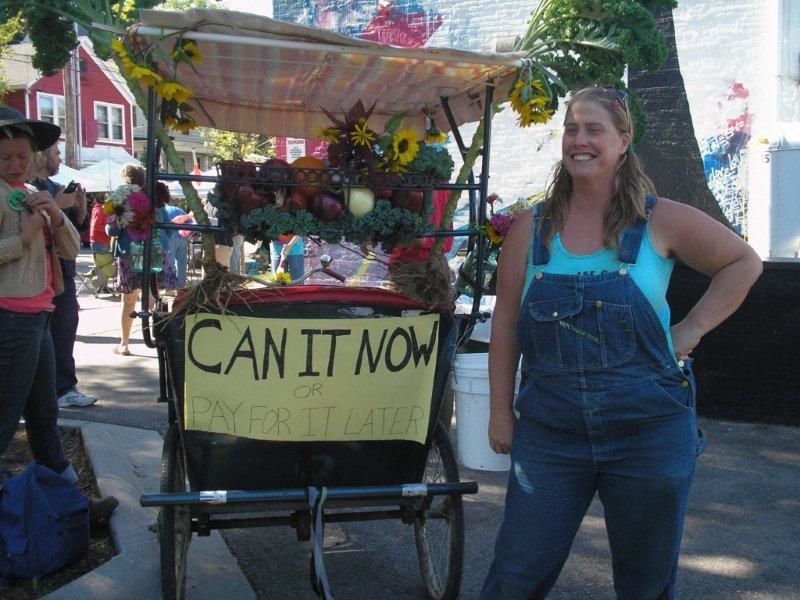
Ringleader Maggie with her decorated rickshaw. Maggie is an expert at canning, freezing, drying, pickling – all forms of food preservation.
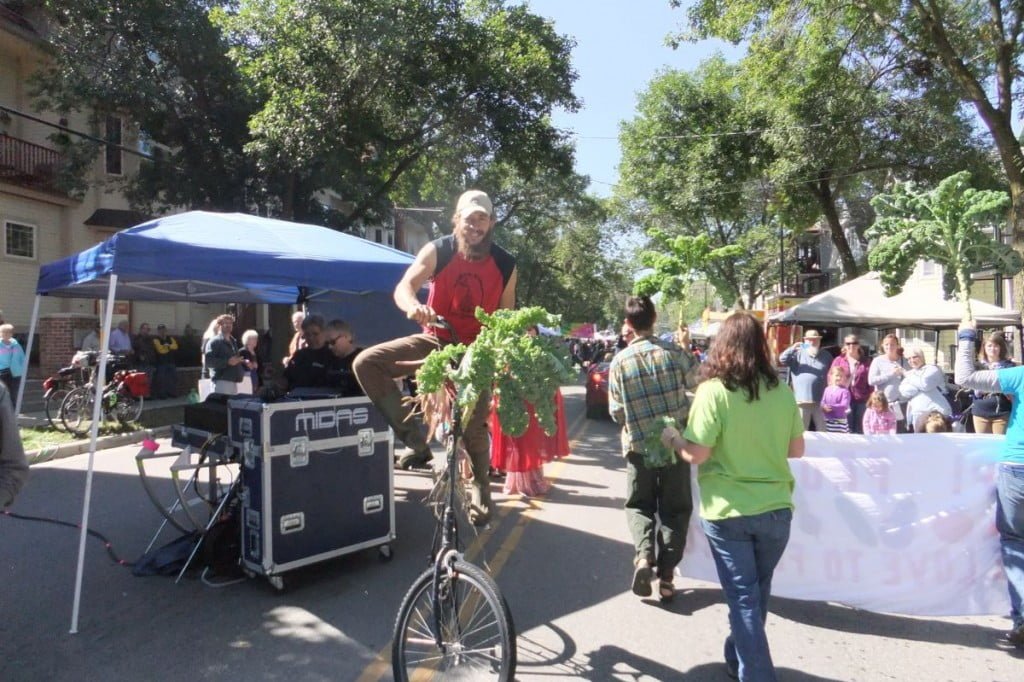
Ringleader Clint dug up beautiful kale plants for us to carry. With their denuded stems, they look just like palm trees.

The kale was a hit with Billy’s son.
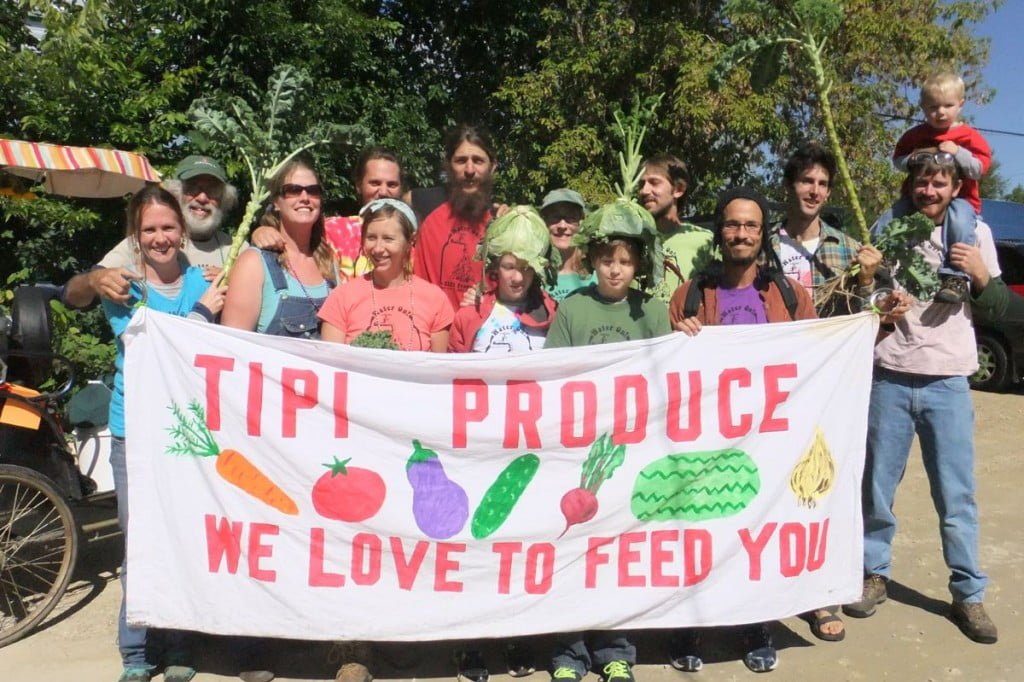
Maggie and her mom made us a banner. We all wore “Water On!” t-shirts that Maggie silk-screened for us a few months ago. From left, Karen, Steve, Maggie, Jory, Bonnie, Clint, the boys with me behind them, Andy, Mario, Jon, Billy with his little boy.
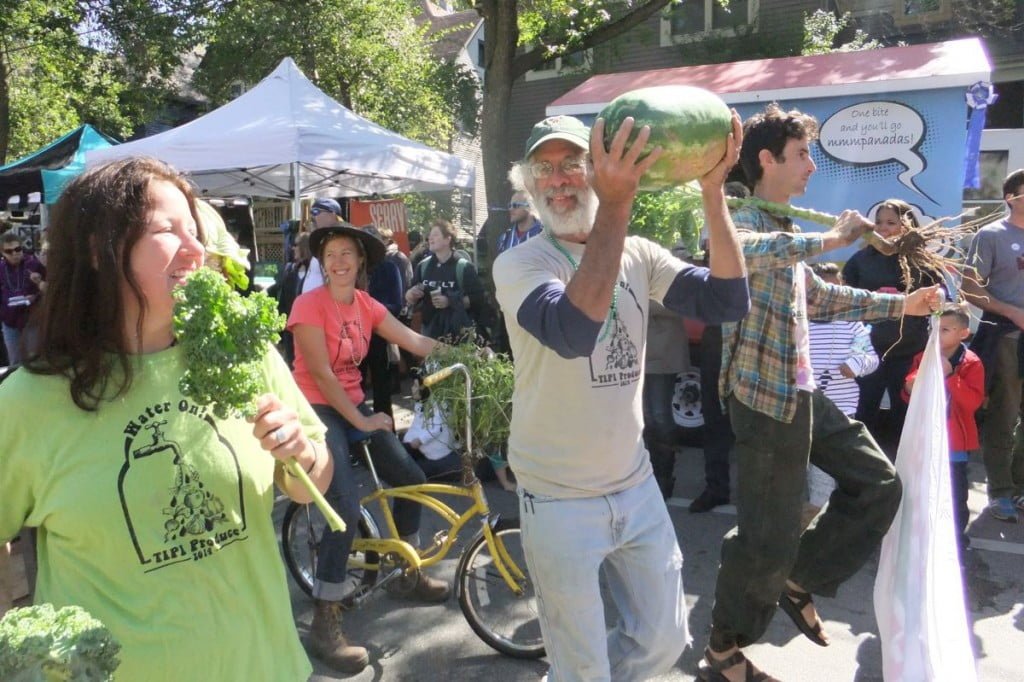
Steve danced his way down the street with a watermelon. We handed out peppers, cherry tomatoes and a few watermelons. We could not hand out candy! Blue (left) joined us for a block during her lunch break. Bonnie rode her festooned bike and handed out produce. Jon marched and twirled his kale stalk as our ‘kale guard’ – it’s like color guard but with a kale stalk instead of a baton.

Our son and his buddy wore cabbage caps. Good thing they are not shy kids.
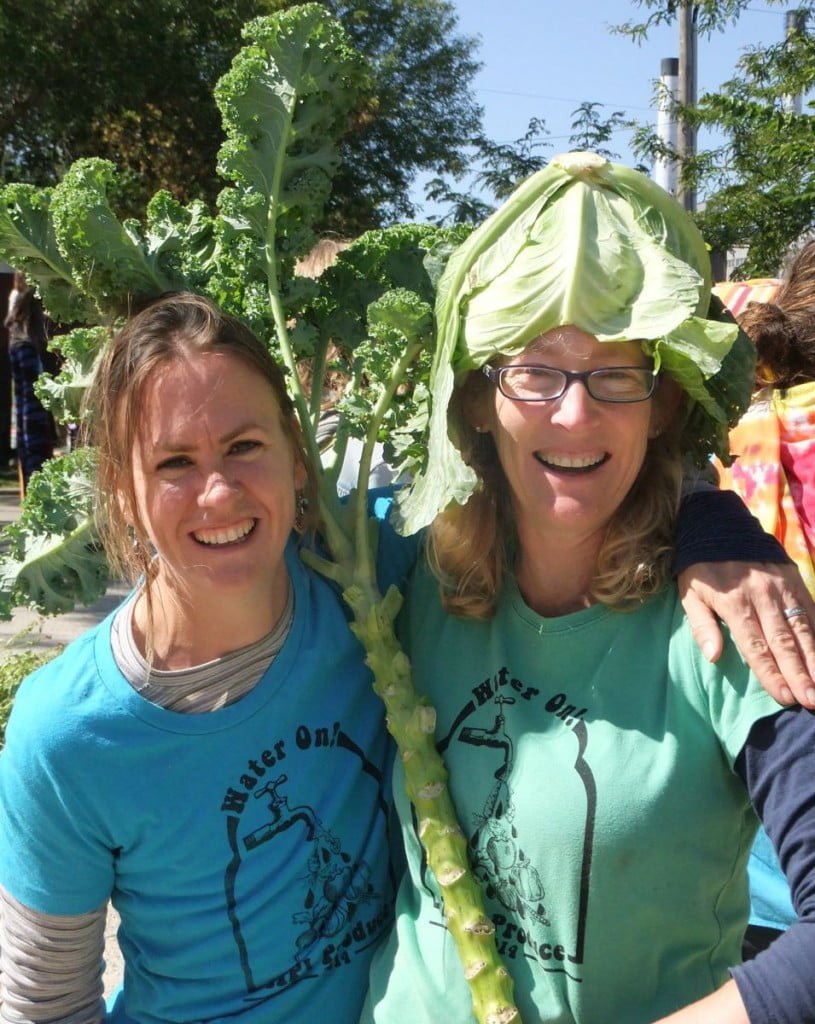
See? Everyone looks good in a cabbage cap. Karen and Beth (that’s me.)
Farm news.
Of course, it’s back to work for us now. There were a few light frosts this past week. We checked the sweet potatoes first – they are our most frost-sensitive crop. Sure enough, the tops of the foliage were singed. That’s a wake-up call for us even though the damage was slight. In summer, time for work seems endless. The weeks go on forever. By this time of year, we can feel the limits of the season yet there is still so much to do. We were glad to wrap up a few summer crops like zucchini and onions, but now we must move on to the next urgent harvests. We have a beautiful winter squash crop, and will hurry to get that and the sweet potatoes tucked away in the next two weeks.
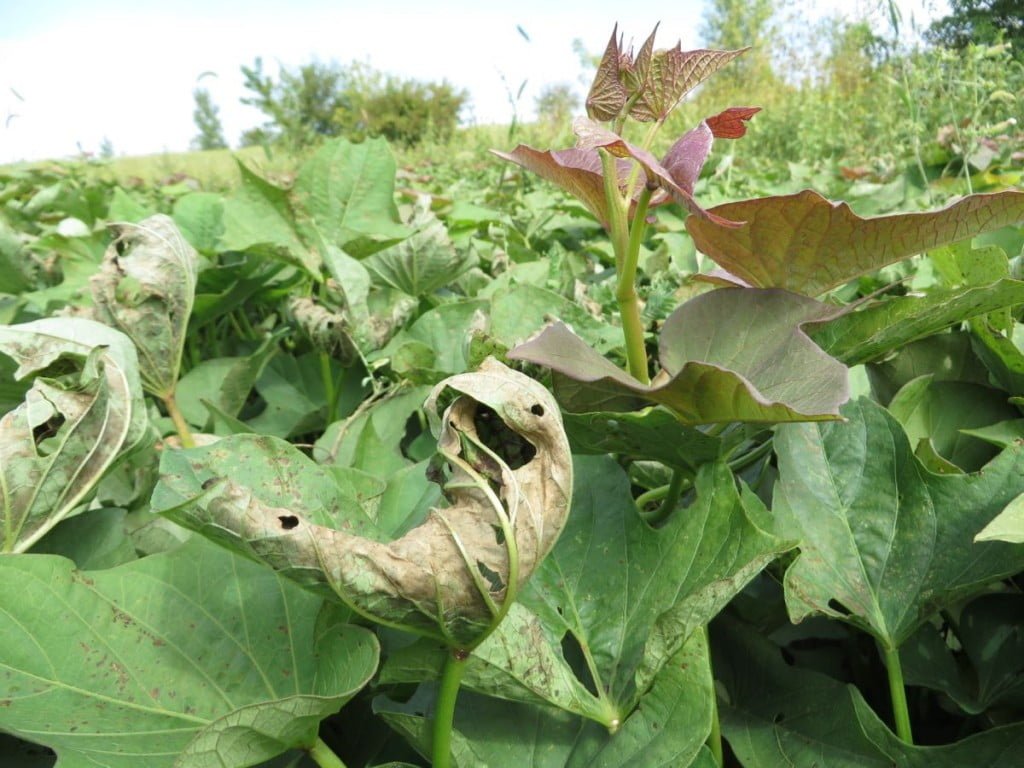
The curled sweet potato leaves were damaged by frost. The damage is not severe, but it is enough to hurry us along.
Veggie list and veggie notes (9/18/14, week #18, purple EOW)
Delicata winter squash, 2
Snap beans, green &/OR yellow, almost 1 lb
Cauliflower AND/OR broccoli, 1 or 2 heads
Slicing tomatoes, 2.4 lb
Broccoli raab, 1 bunch
Green bell pepper, 1
Red bell pepper, 1
Scallions, 1 bunch
Yellow onions, 2
Purple OR green kohlrabi
Jalapeño (hot), 1
Next week’s box will probably contain snap beans, fall brassicas (cabbage/cauliflower/broccoli), tomatoes, peppers, carrots, winter squash, poblano chiles and more.
Delicata winter squash – These are flavorful, thin-walled winter squash. You can even eat the skin. Like the Sweet Dumpling we sent last week, delicata will not store for long, so eat them soon. There may be flaws that need trimming before or after cooking.
Storage: Store all winter squash at room temperature.
Preparation: These squash have a central cavity that can be stuffed if you wish. Cut squash in half, scoop out and discard the seeds. To cook, I place the cut squash face-down on a cookie sheet, then put some water in the pan, and roast at 400 oF until easily pierced with a fork. The water in the pan is optional. The flavor is best if you allow the pan to dry during the cooking, so the squash has a chance to caramelize.
Purple OR green kohlrabi – Crunchy and sweet, kohlrabi is a great addition to salads. Some of the purple kohlrabi are scarred from strong storms last month. The green kohlrabi from the adjacent row show no damage. They are simply sturdier. We see this with a lot of red or purple vegetables. They are pretty but often less vigorous than their green counterparts.
Storage: Kohlrabi bulbs will store for a month in the refrigerator.
Uses: Kohlrabi are good peeled and eaten out of hand, or added to sandwiches. It is good mixed into salads, or prepared as a salad on it’s own. You can grate it, slice it, or cut it into matchsticks. It’s also good cooked. If you have it, the Asparagus to Zucchini cookbook has a long list of kohlrabi suggestions.
Broccoli raab (large bunch of tender greens) – This cool-season vegetable is also known as rapine, and is similar to “broccolini.” Has a robust flavor similar to mustard greens. Broccoli raab is harvested with young flowering stalks. Chop and include these tender stalks when cooking. Similar cooking time to mustard or turnip greens. After years of trying, this is our first successful crop of this nutrient-rich green.
Jalapeño (small, dark green or red chile) – These are hot.
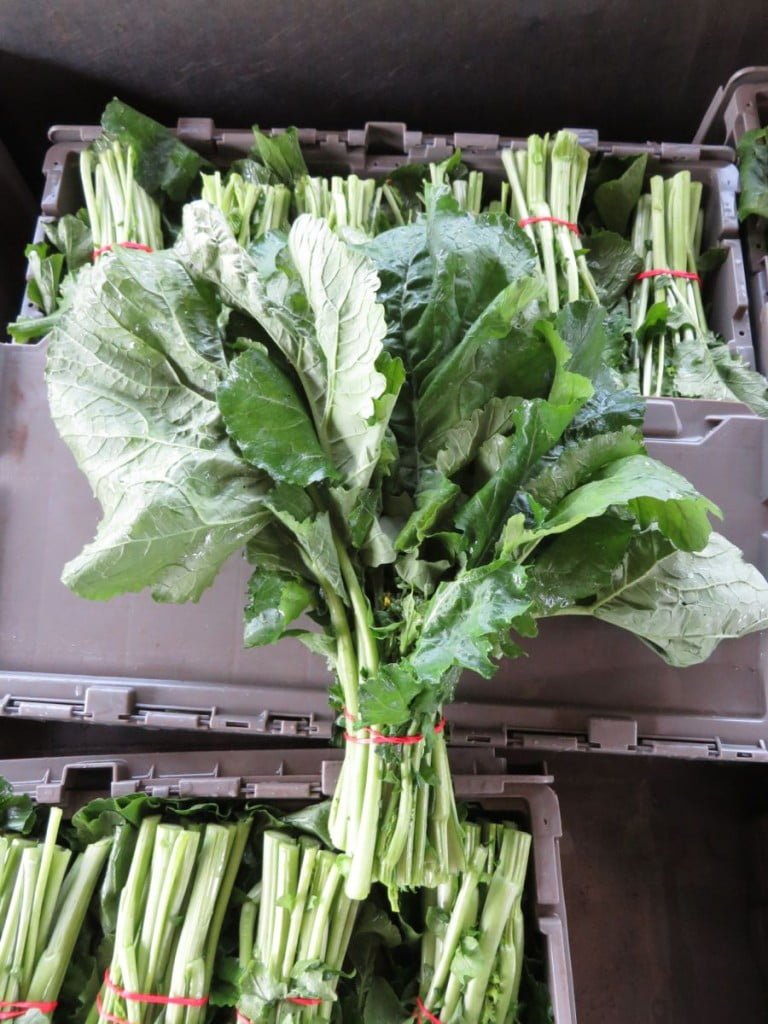
A generous bunch of broccoli raab.
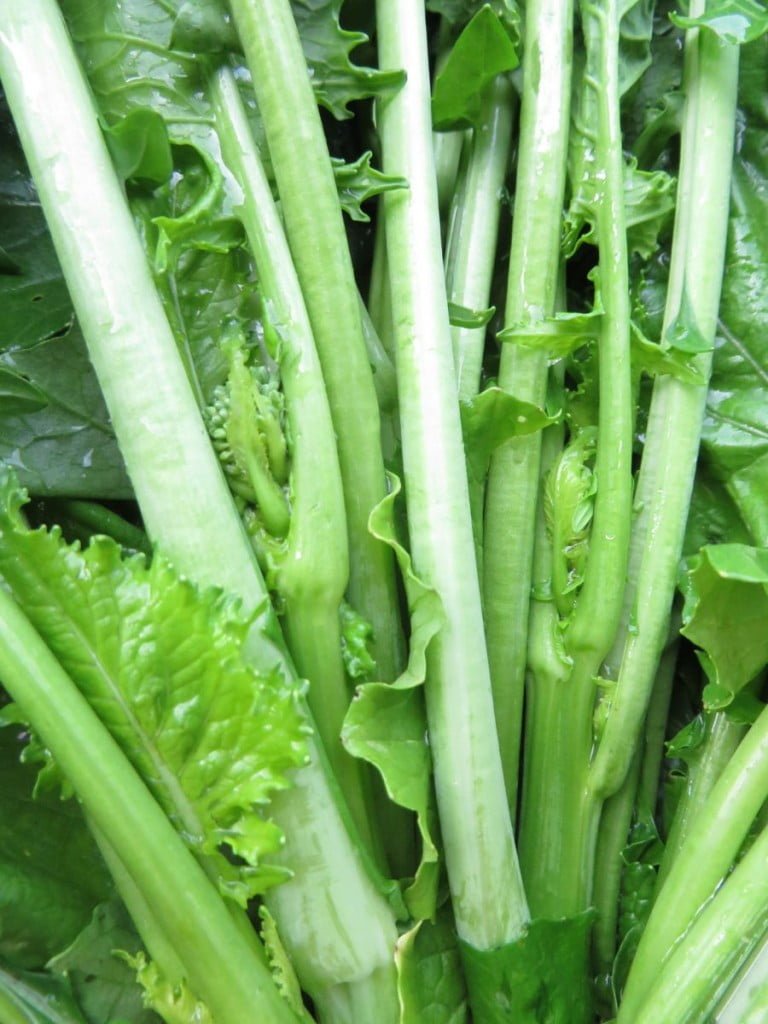
Include the tender flower stalks when you cook the broccoli raab.

